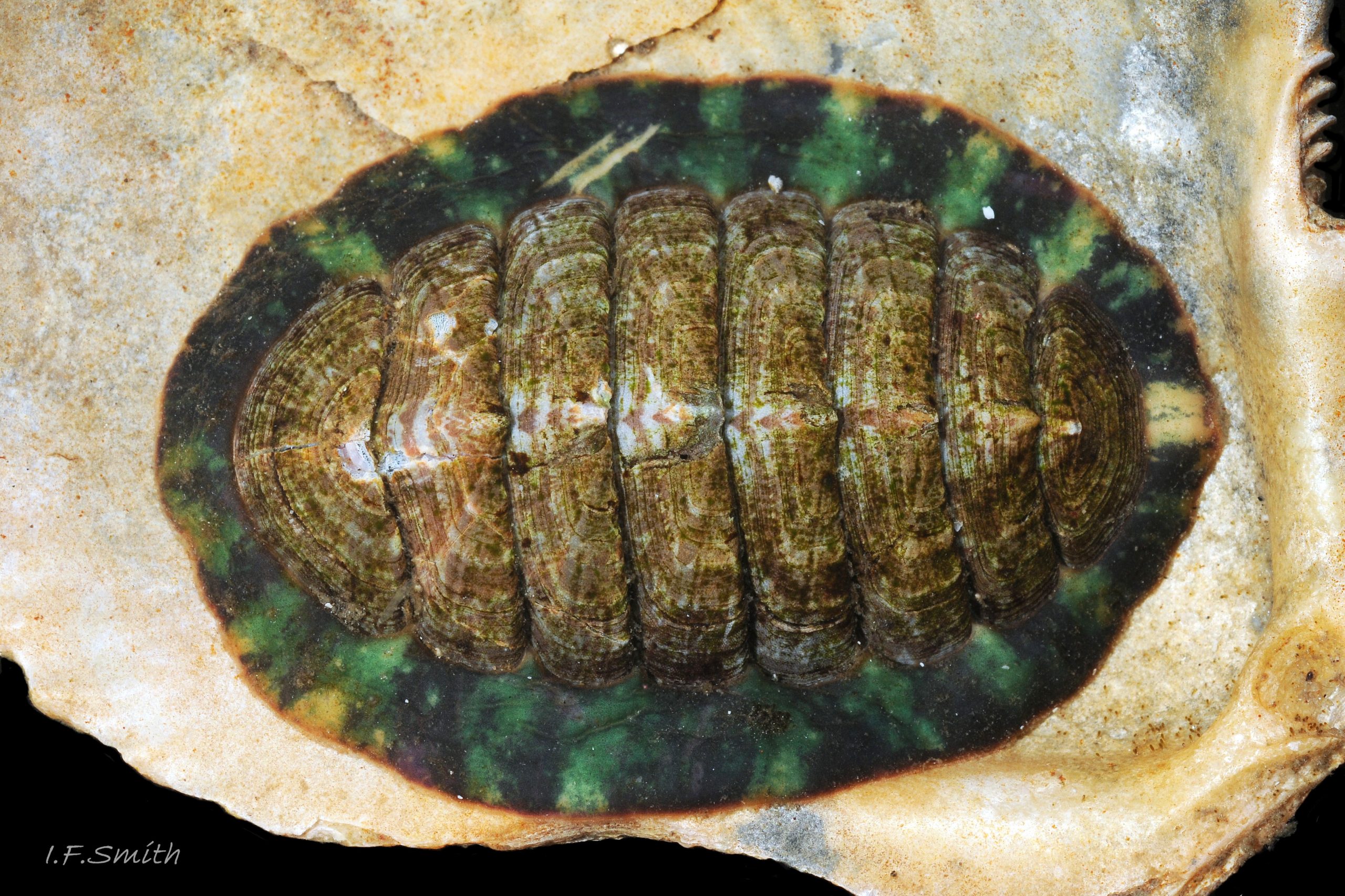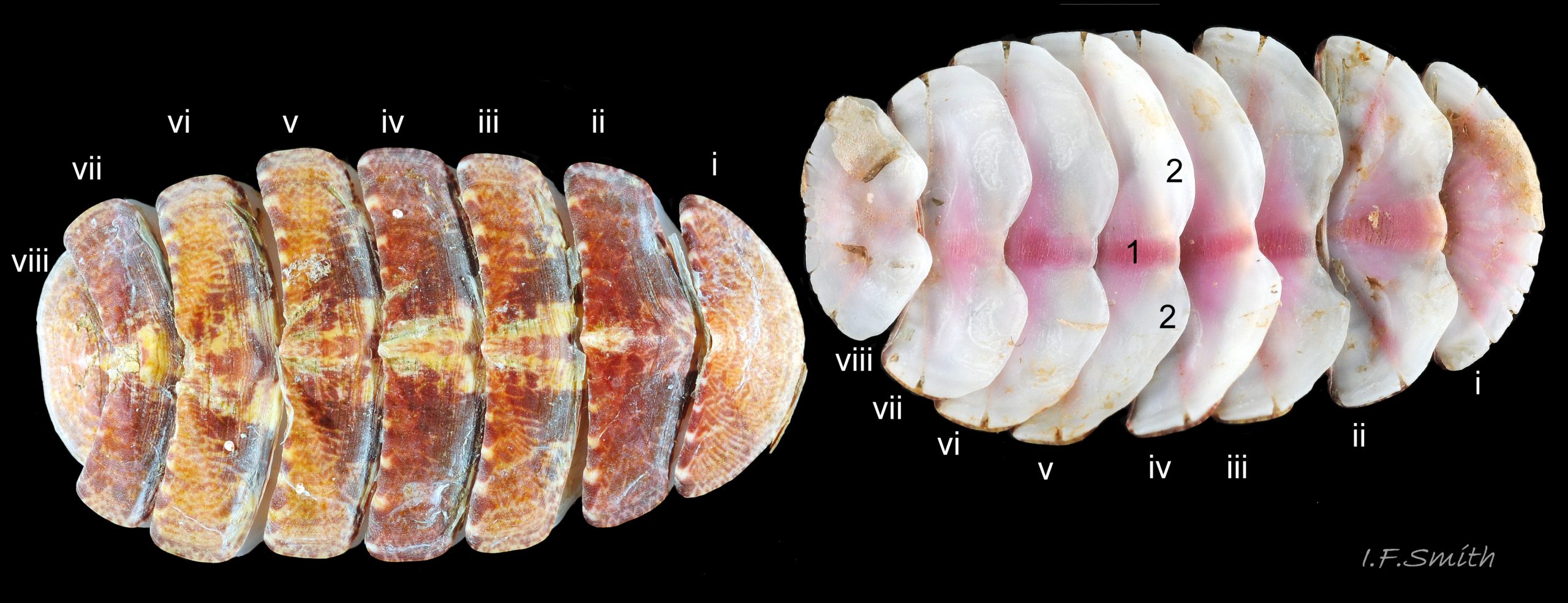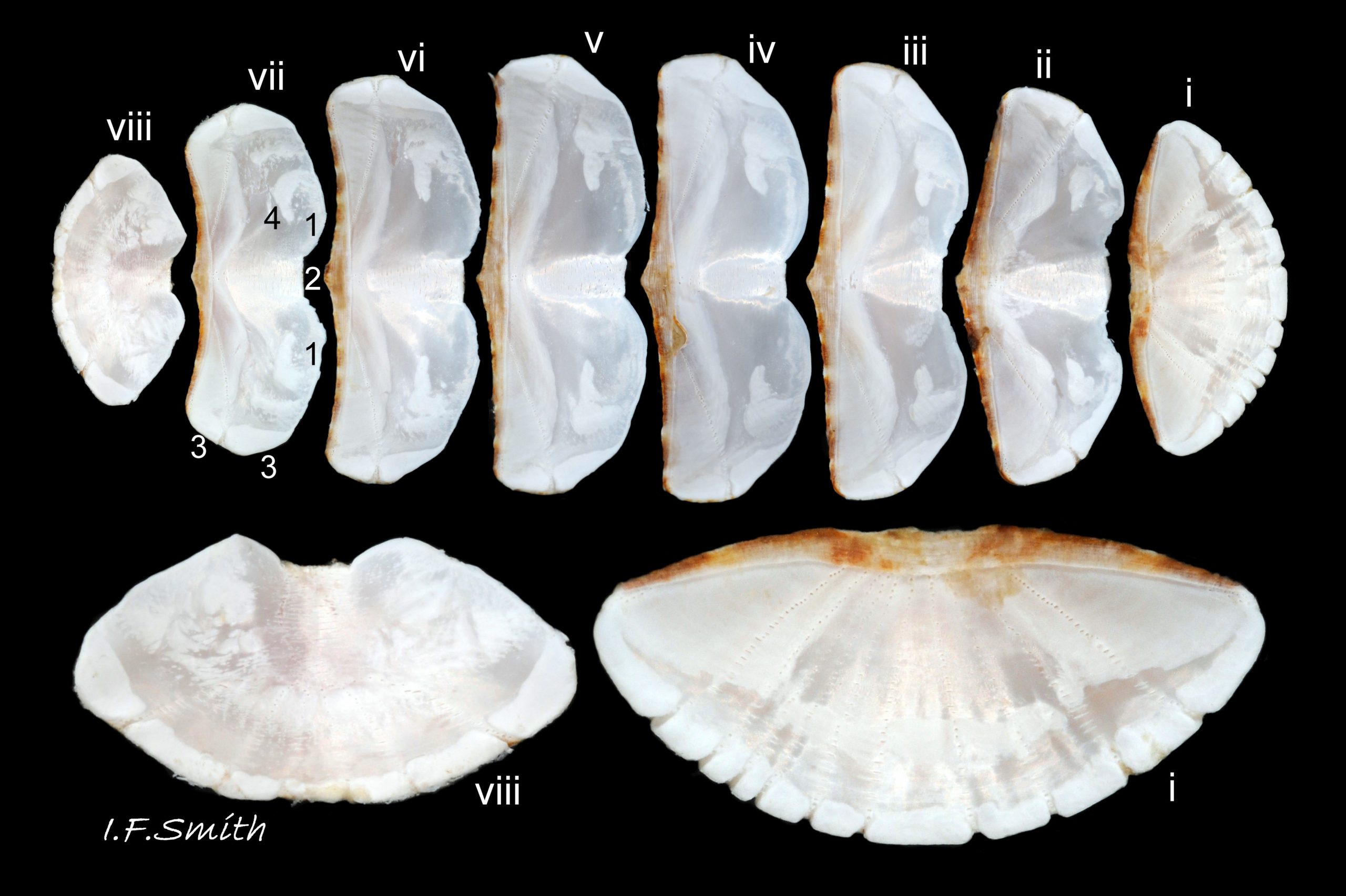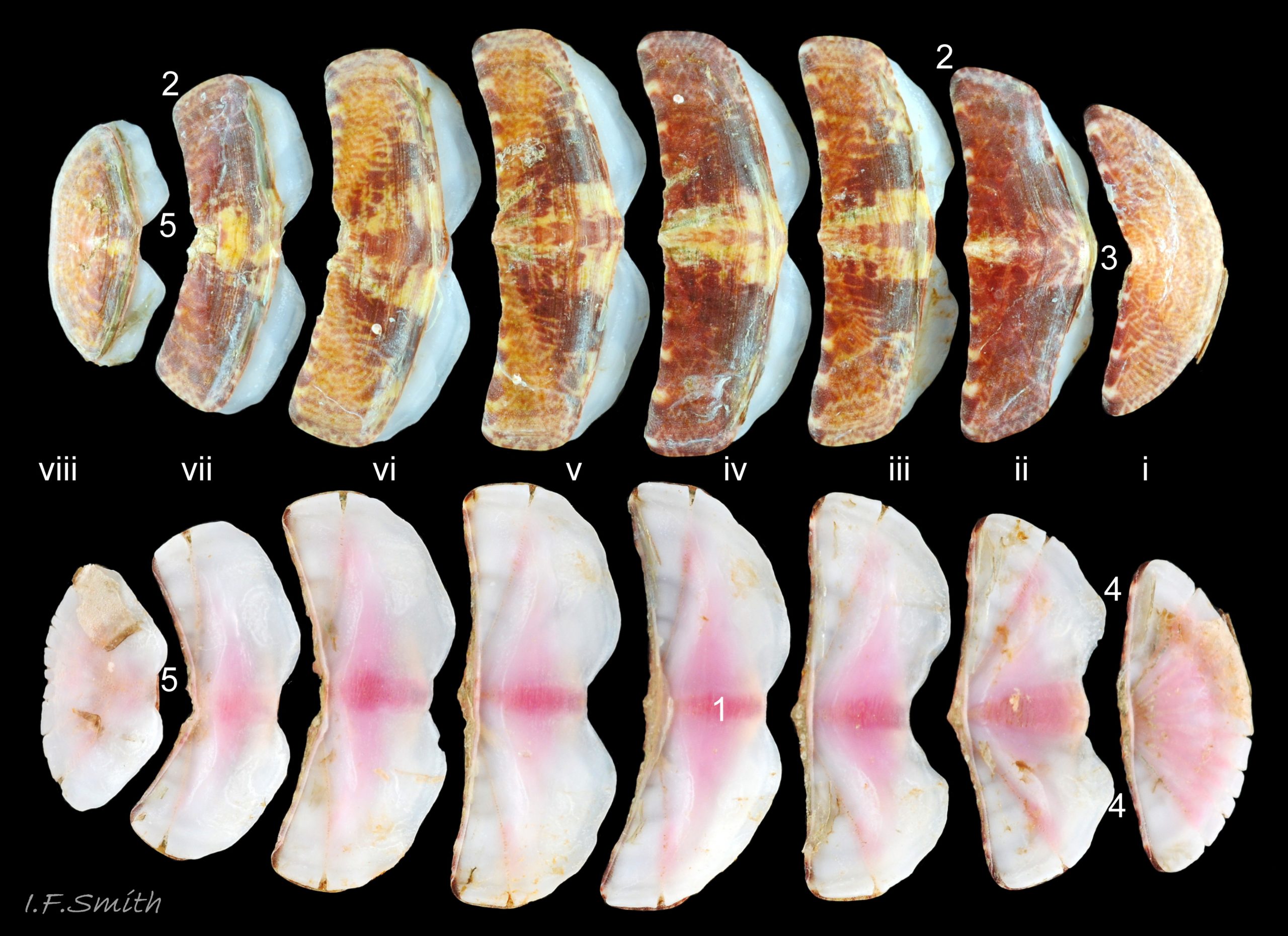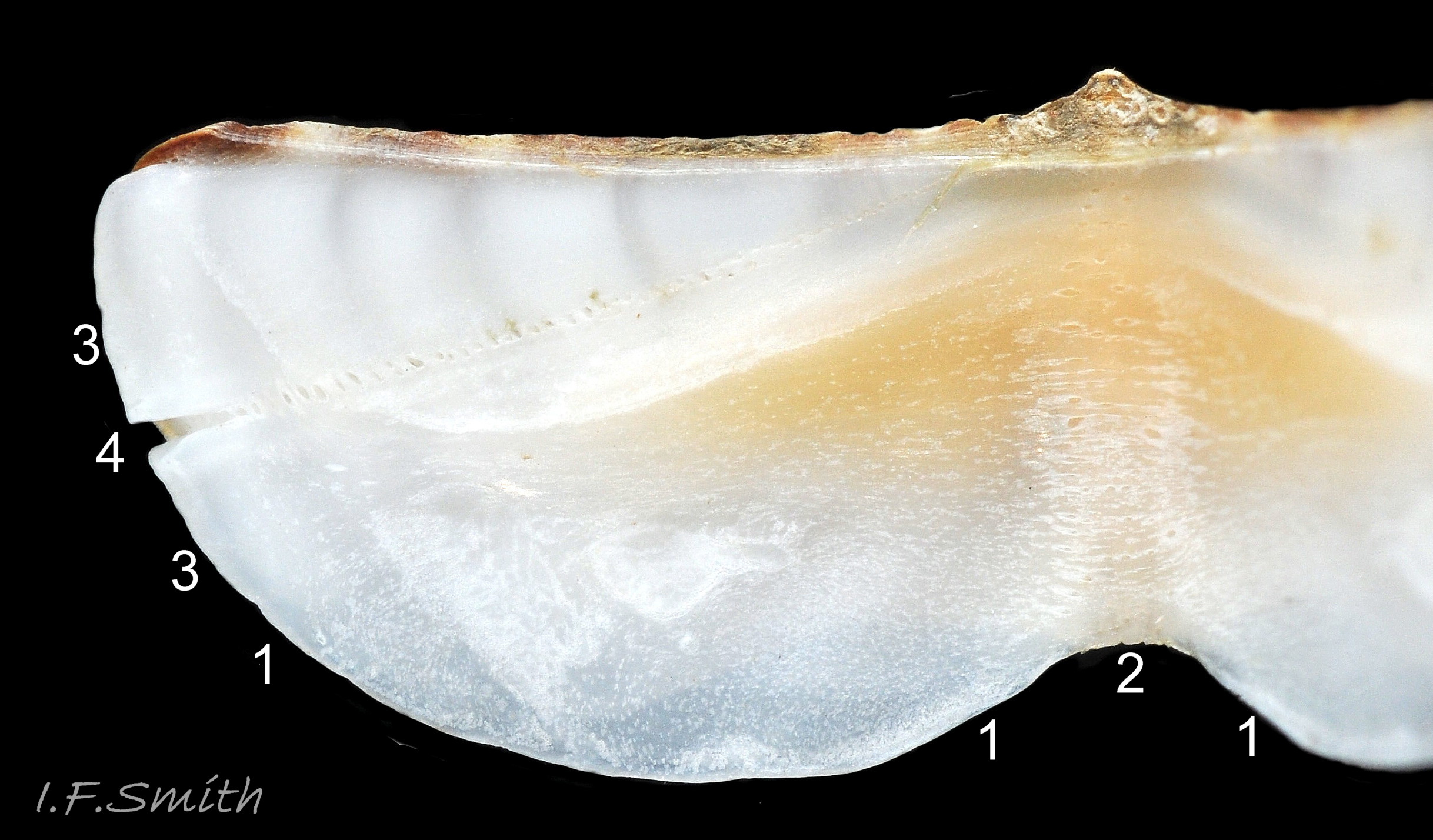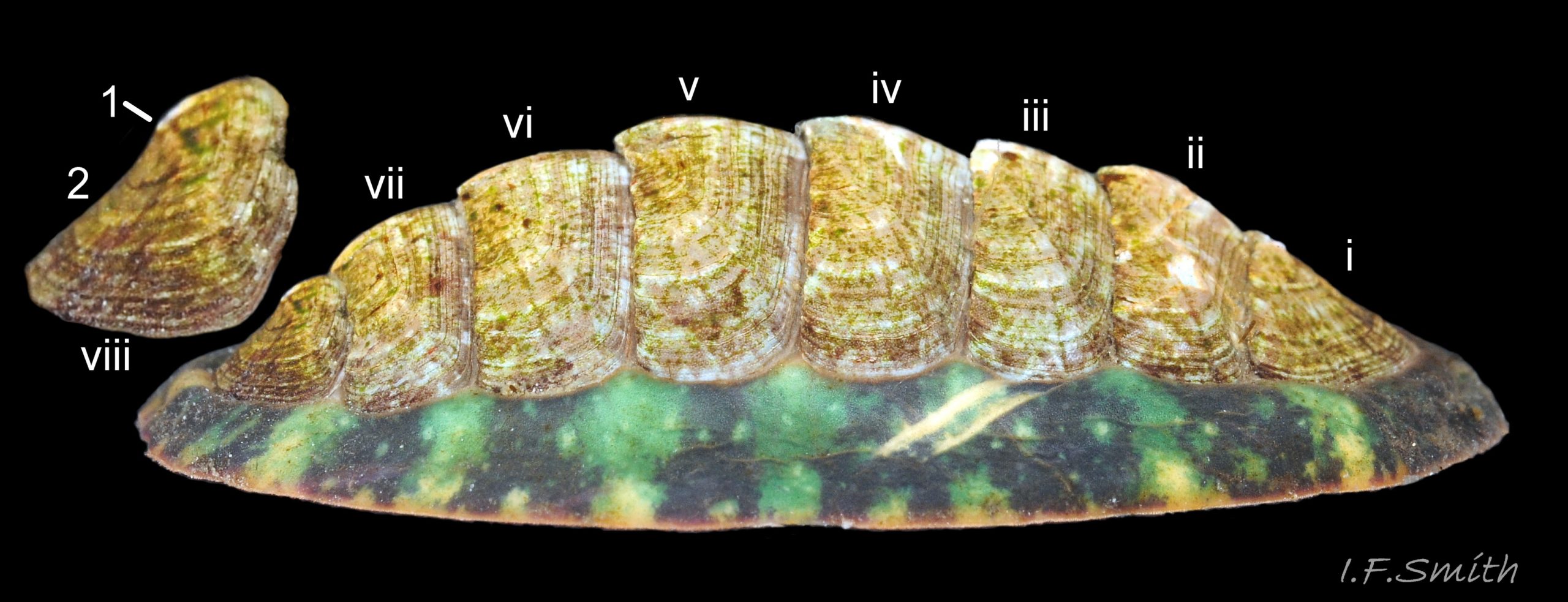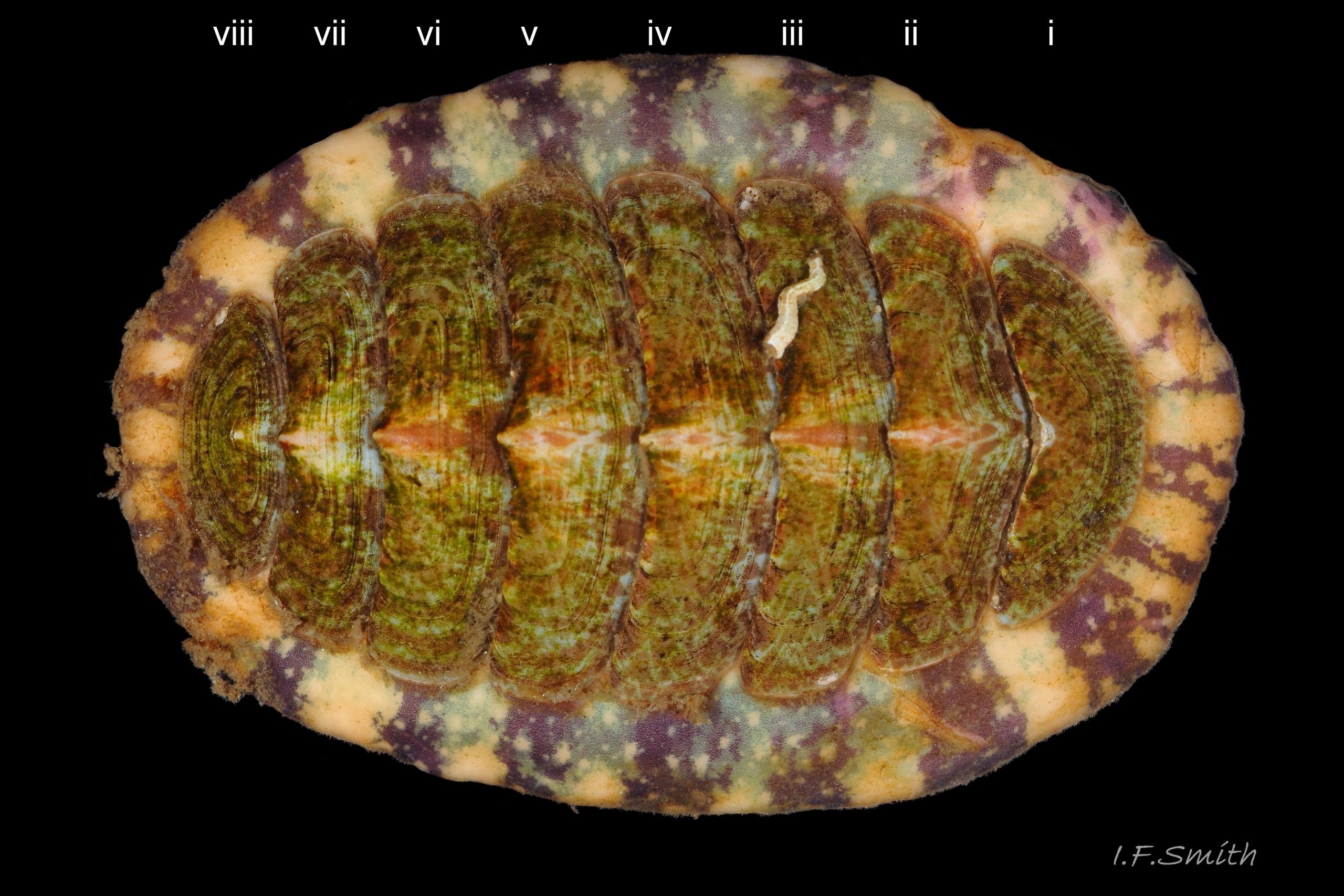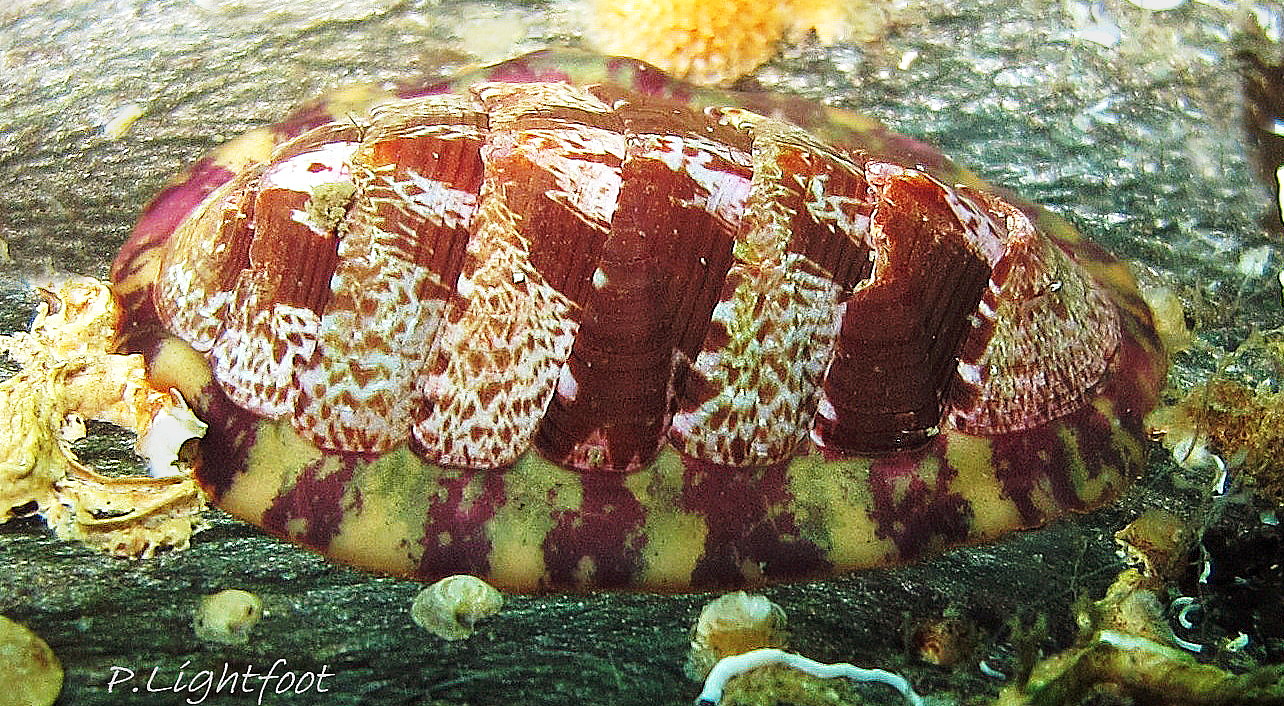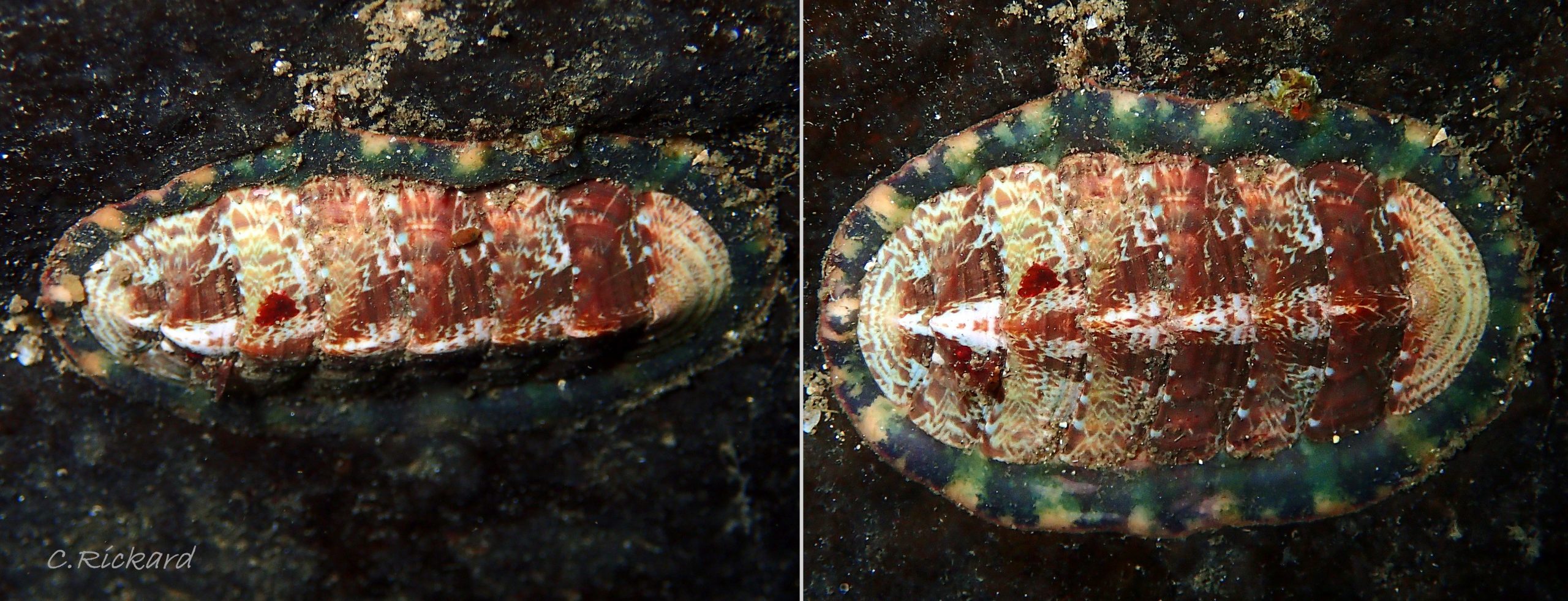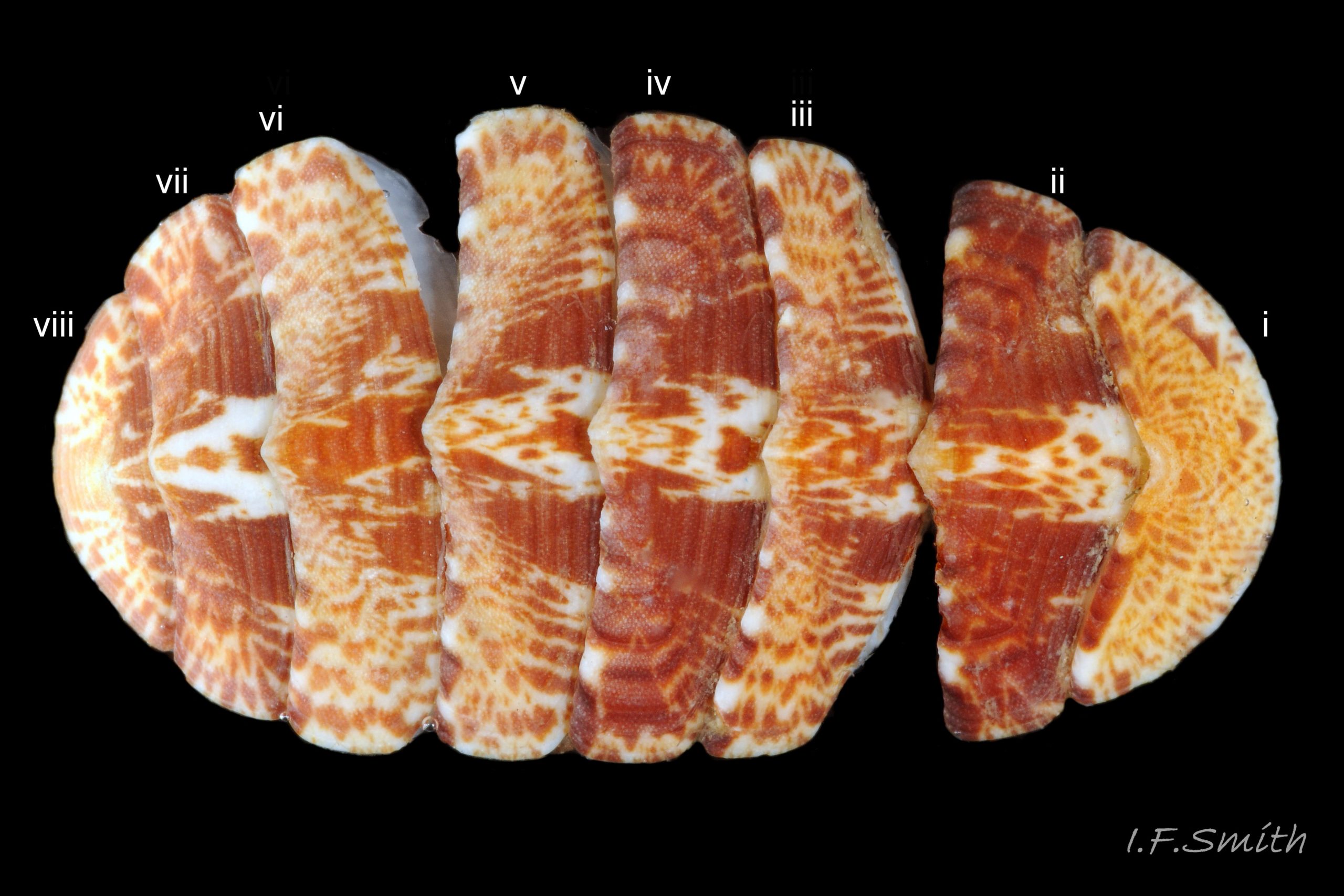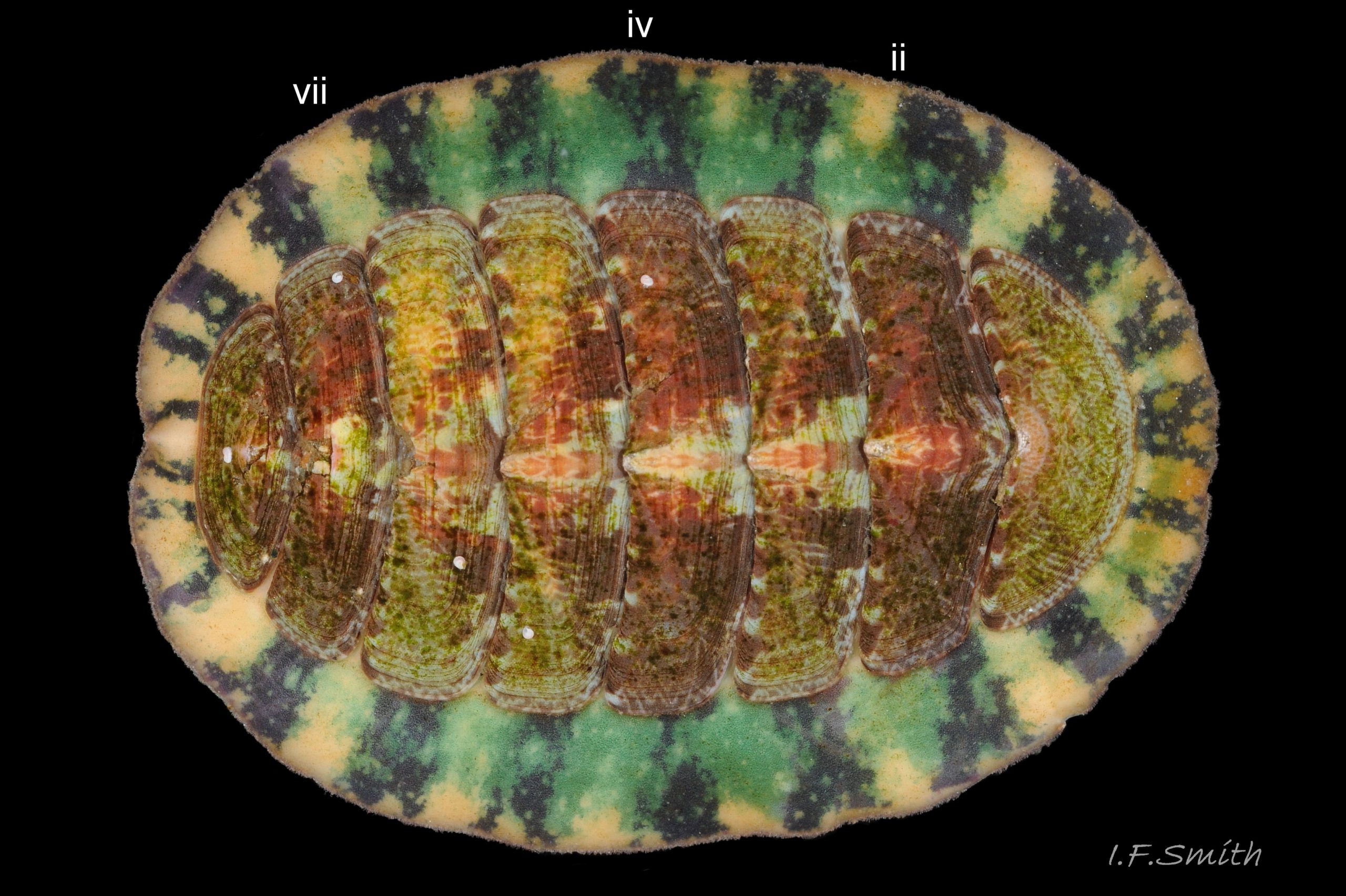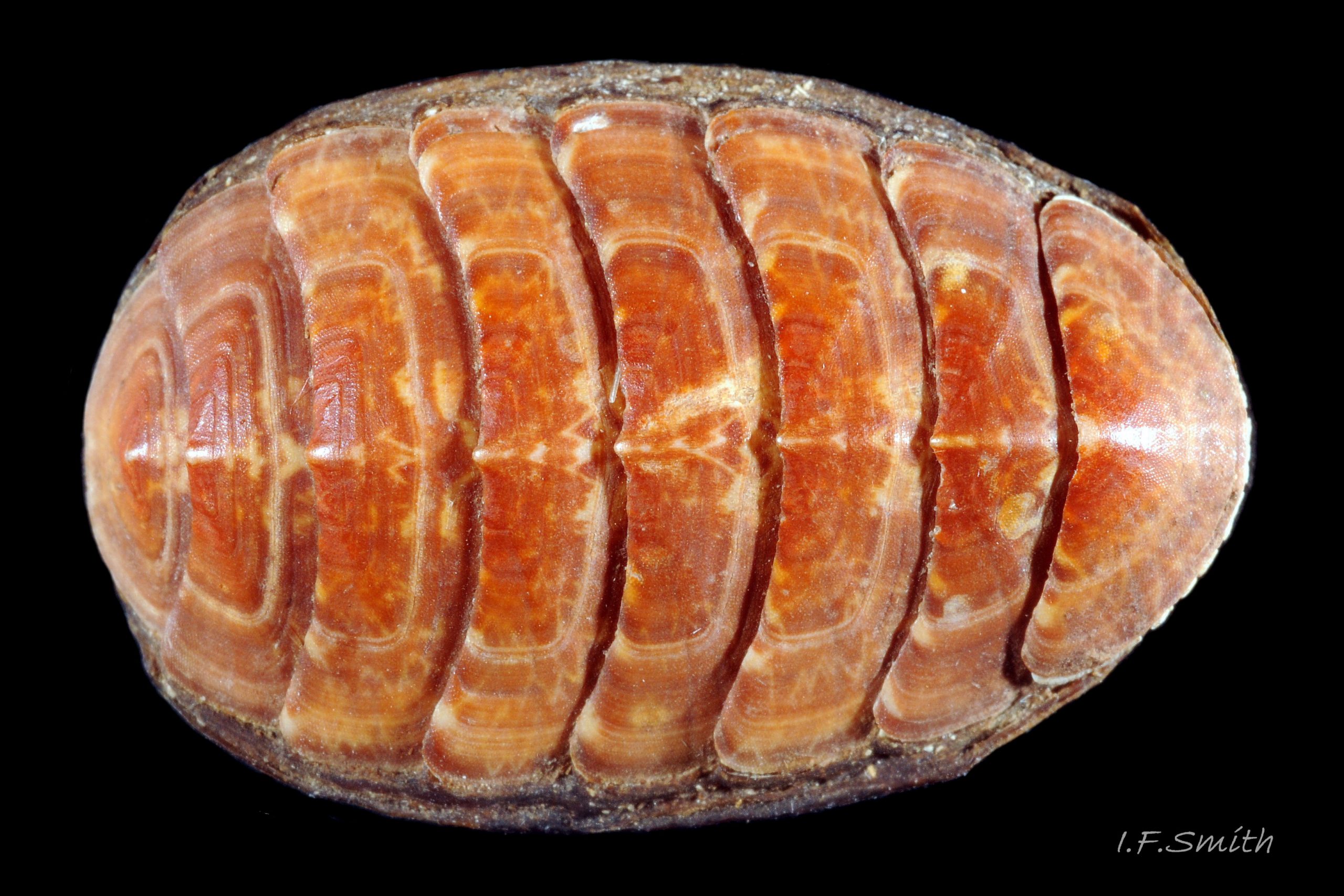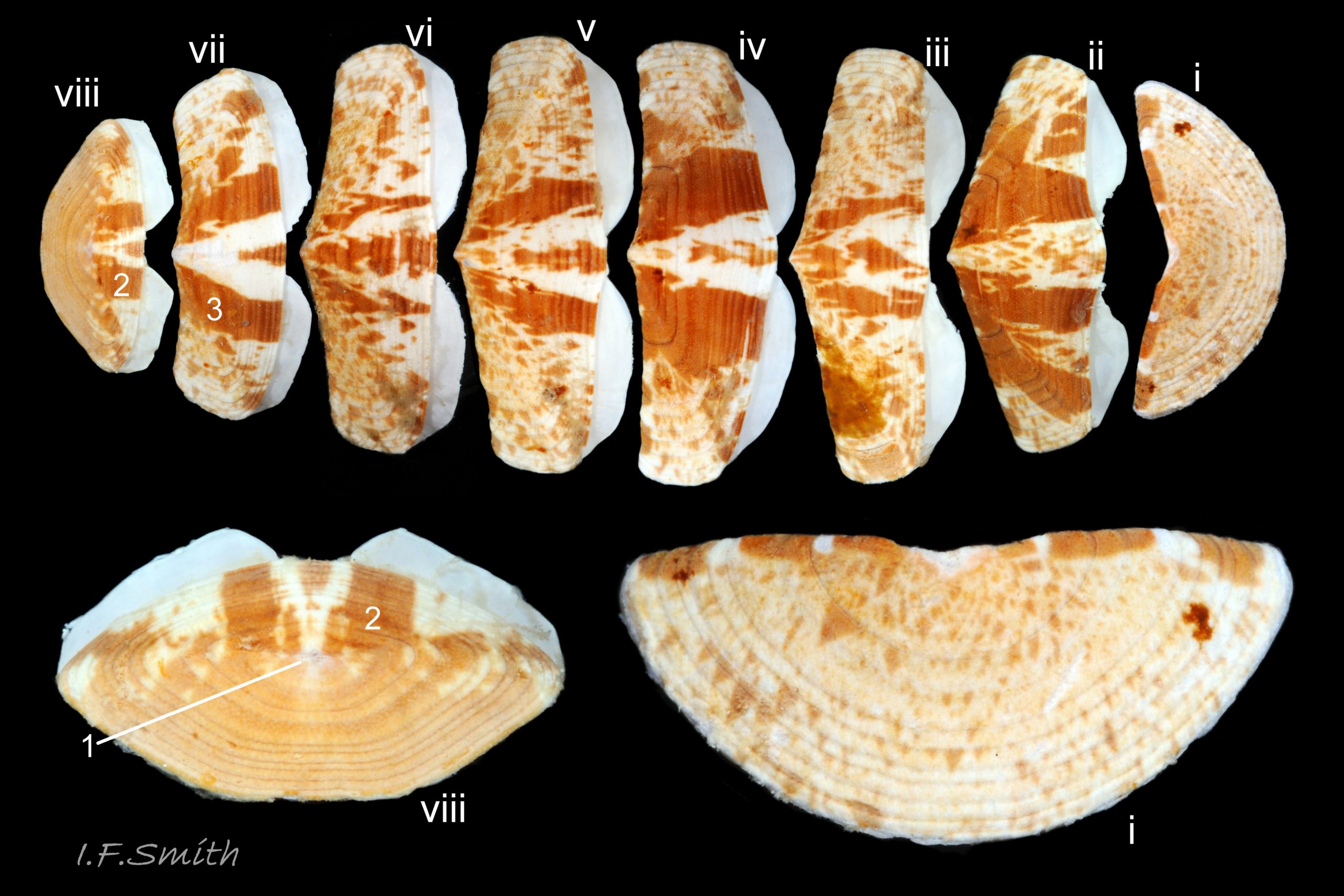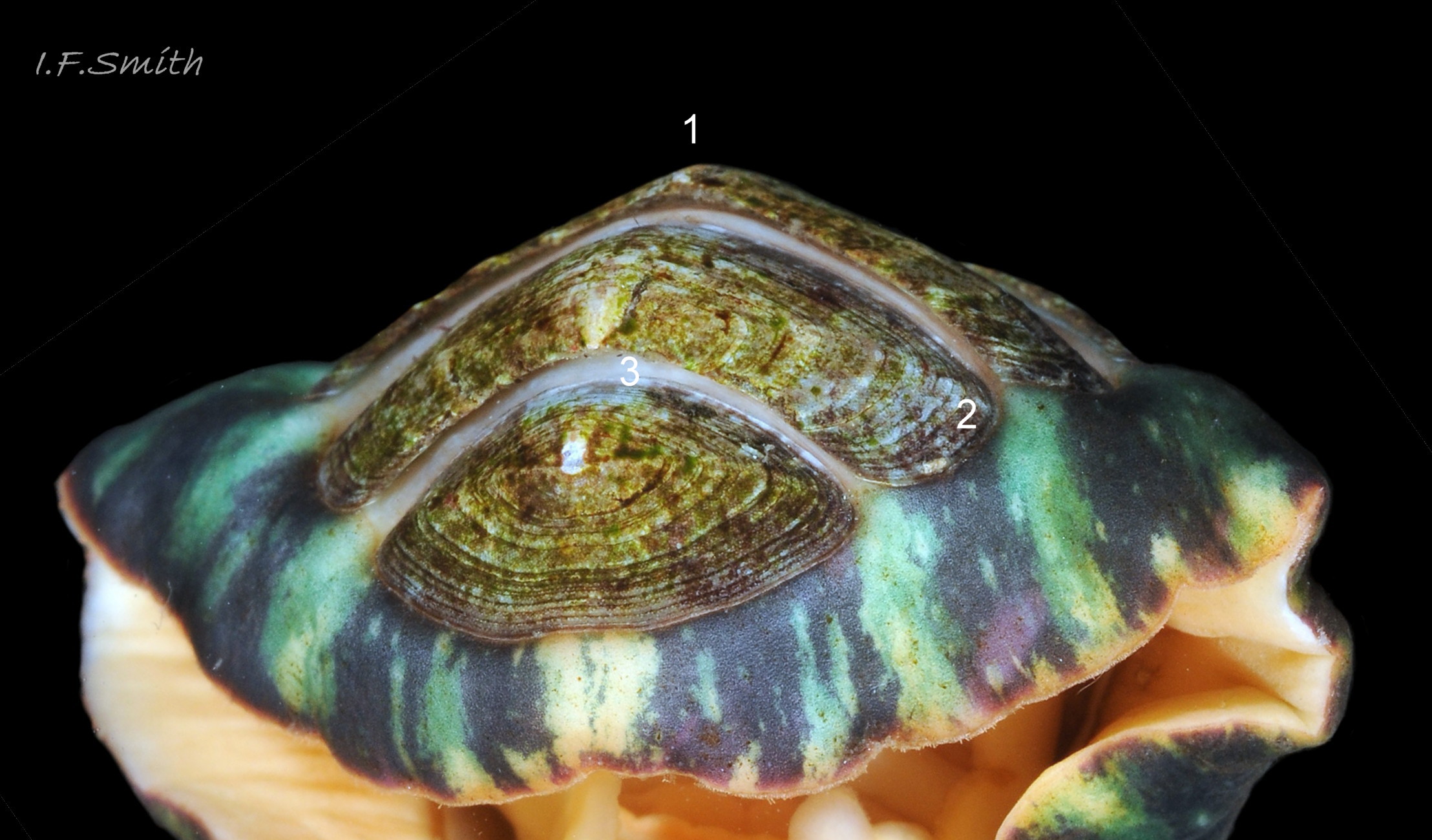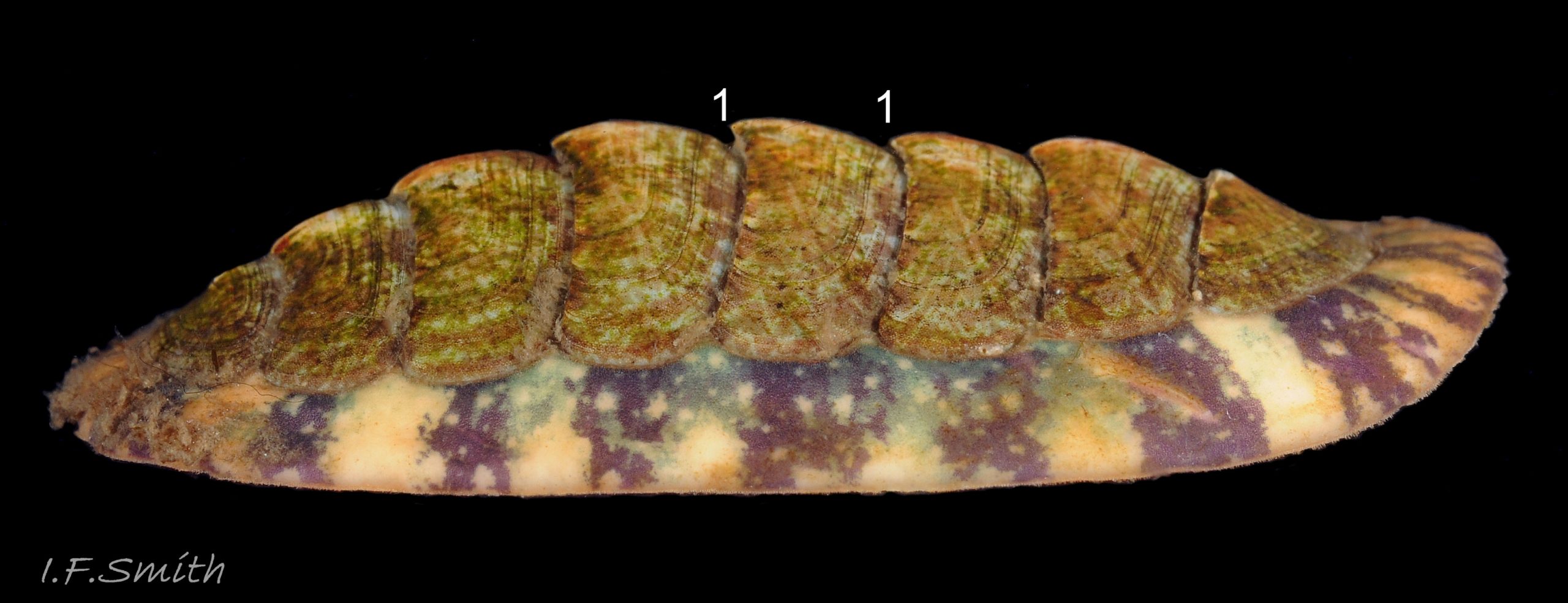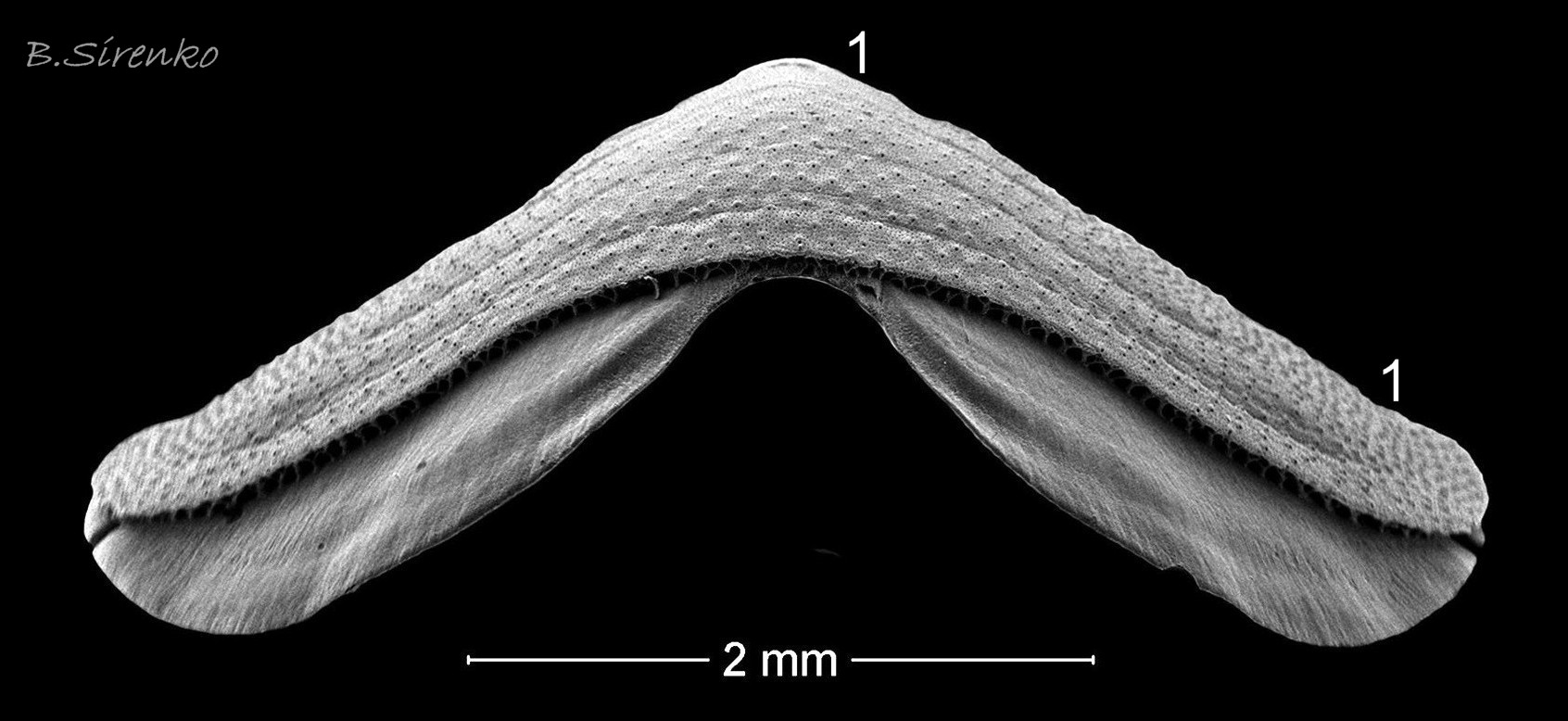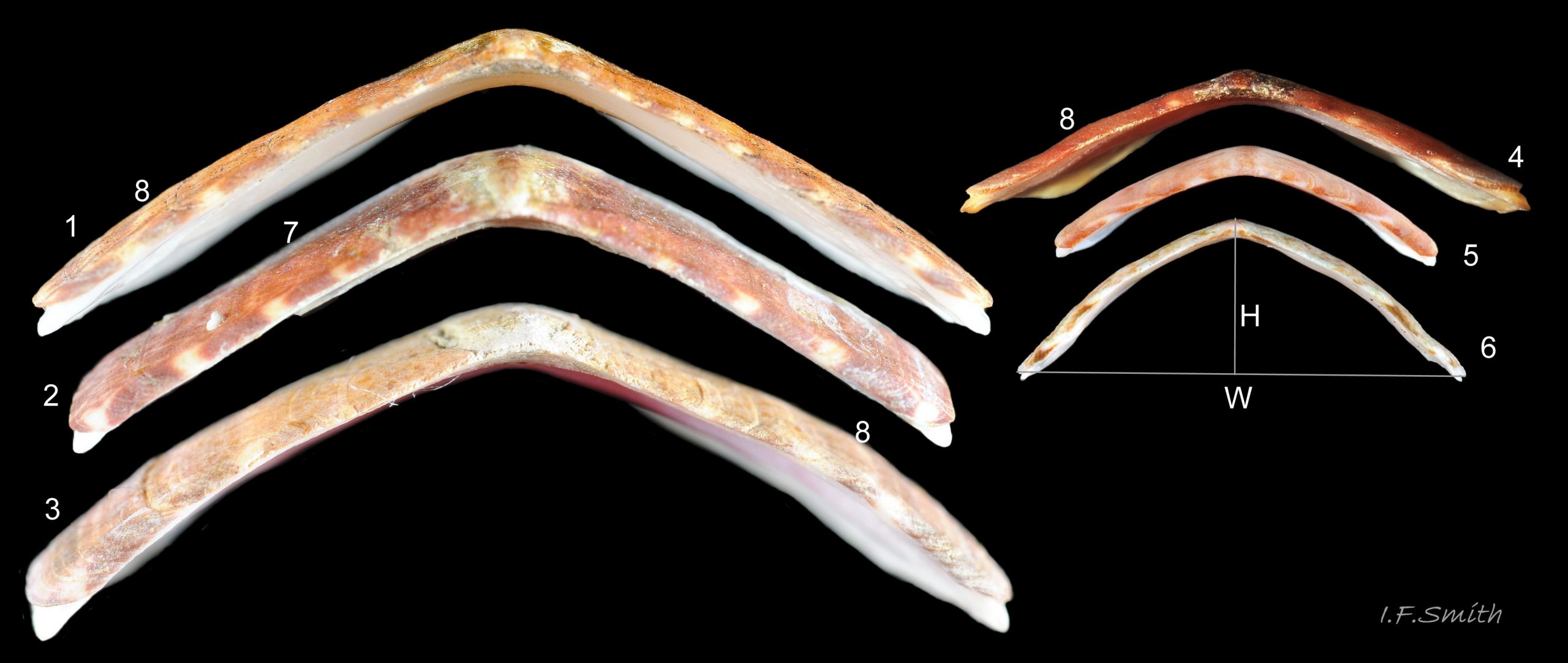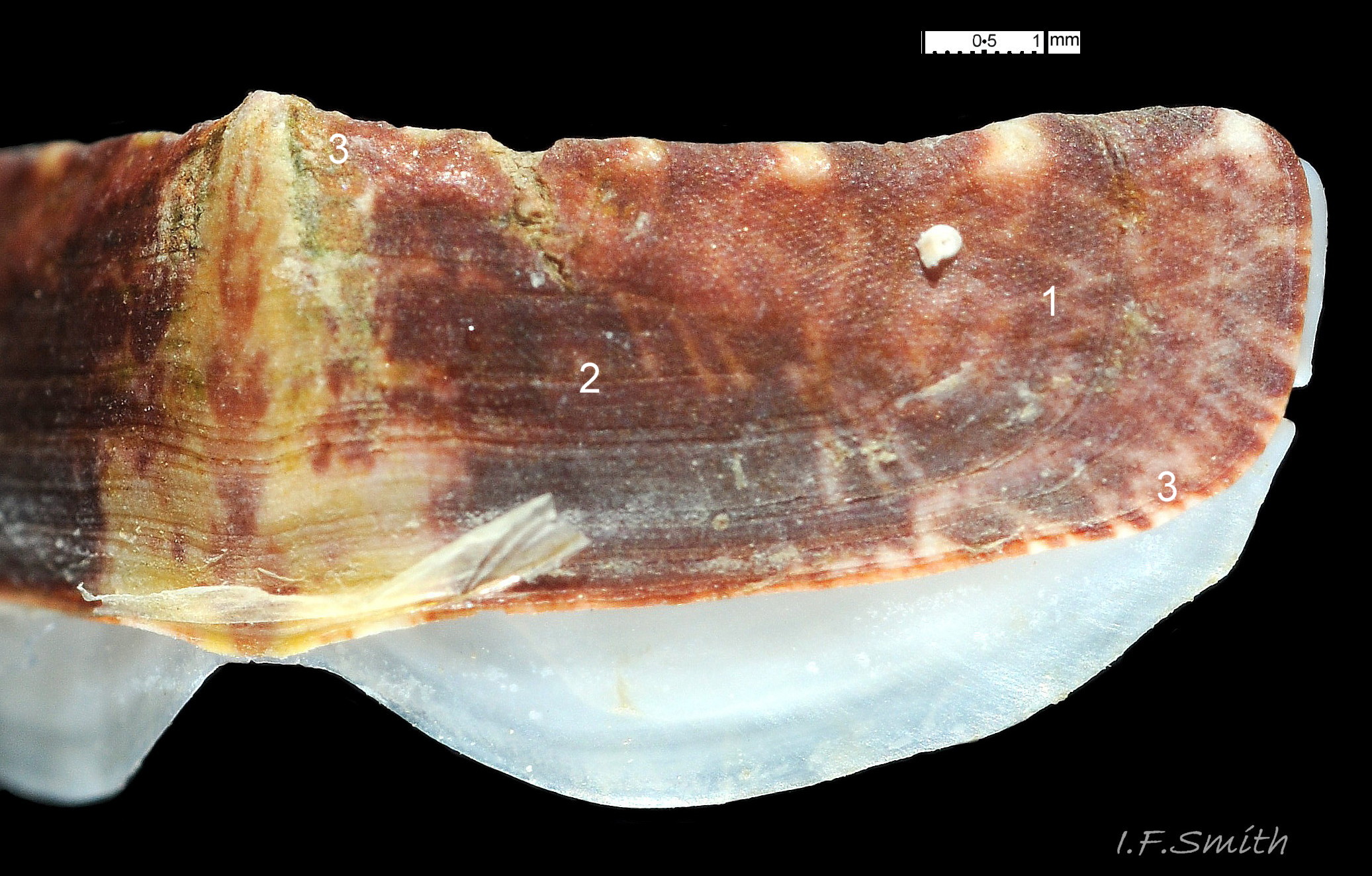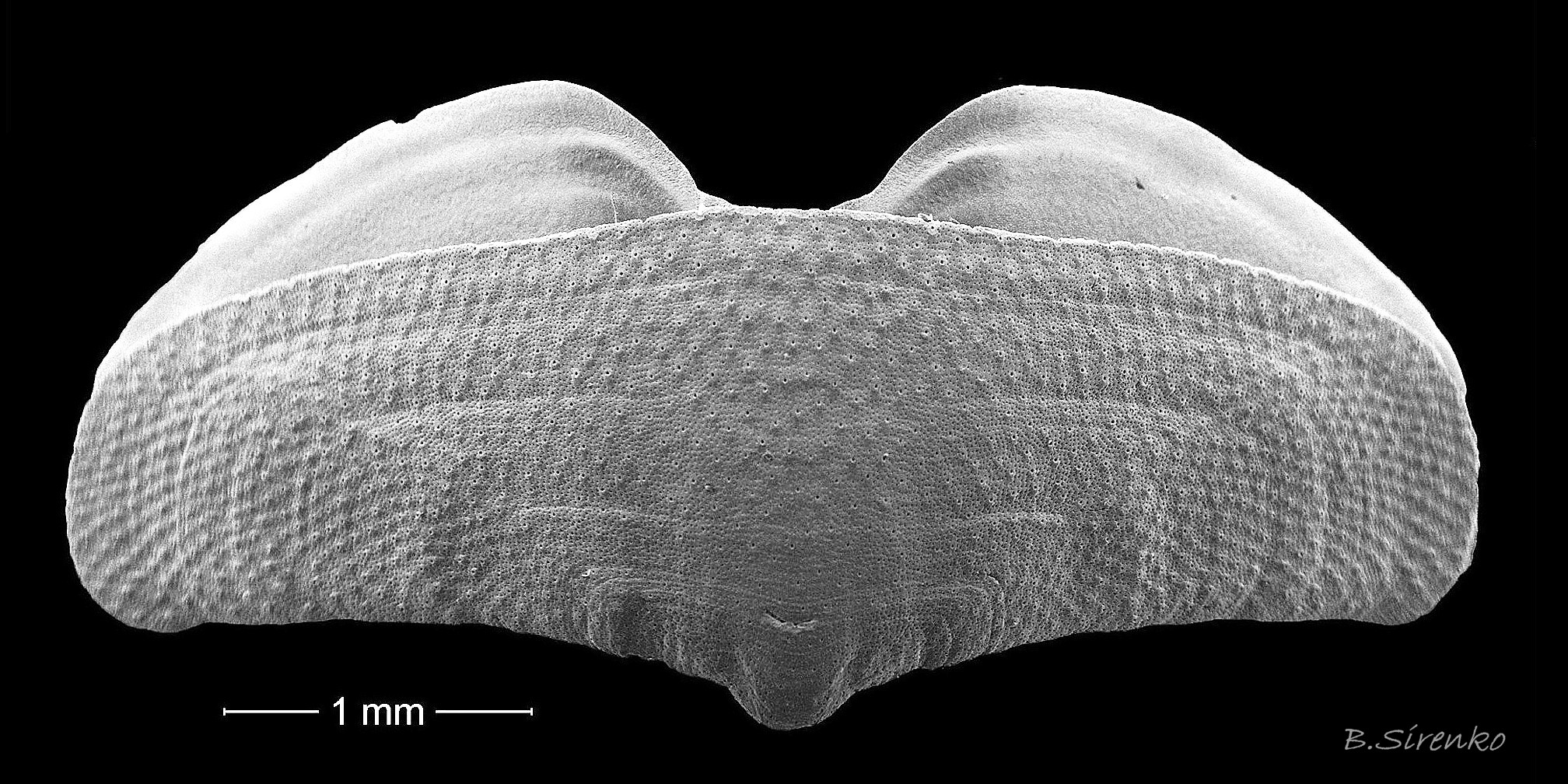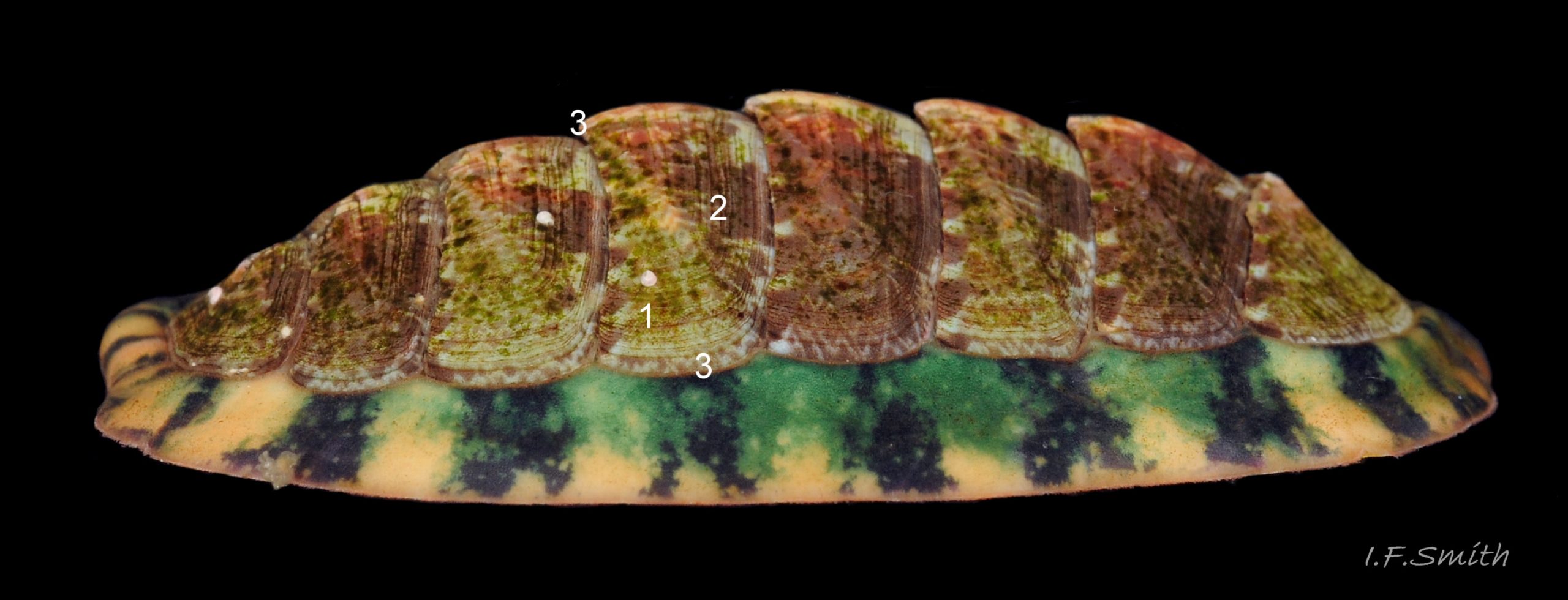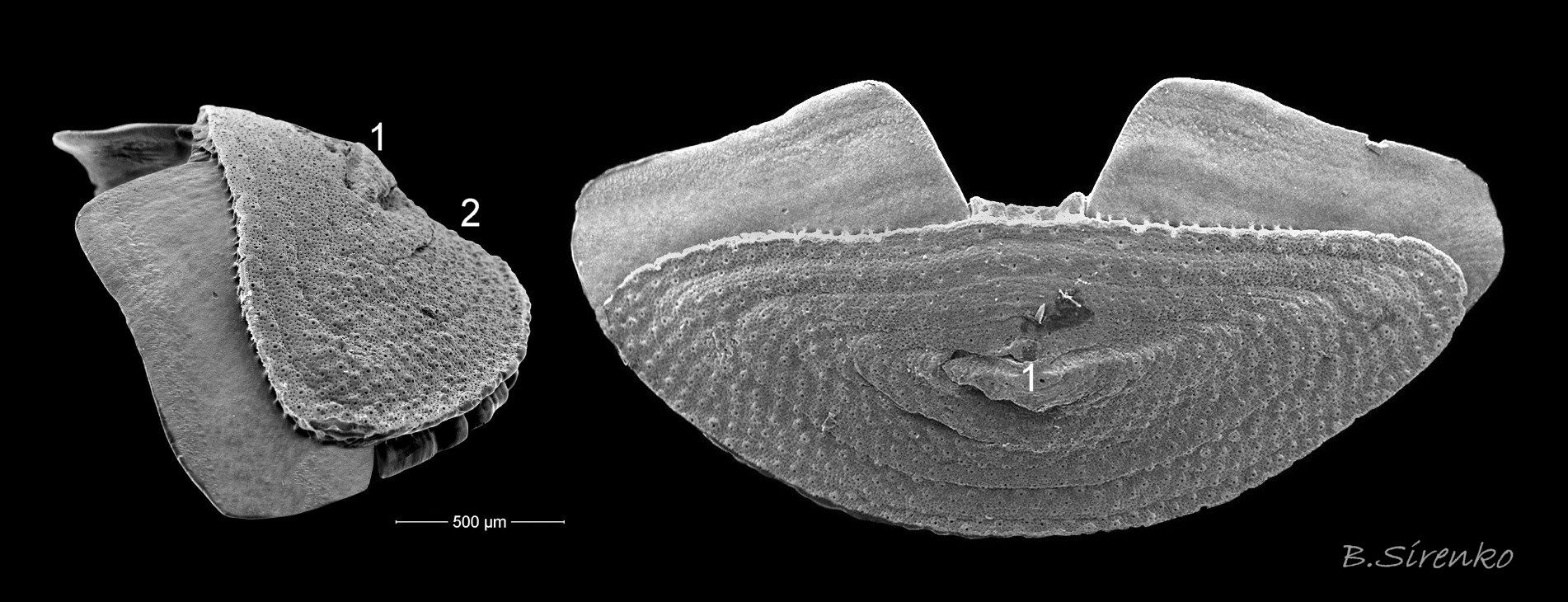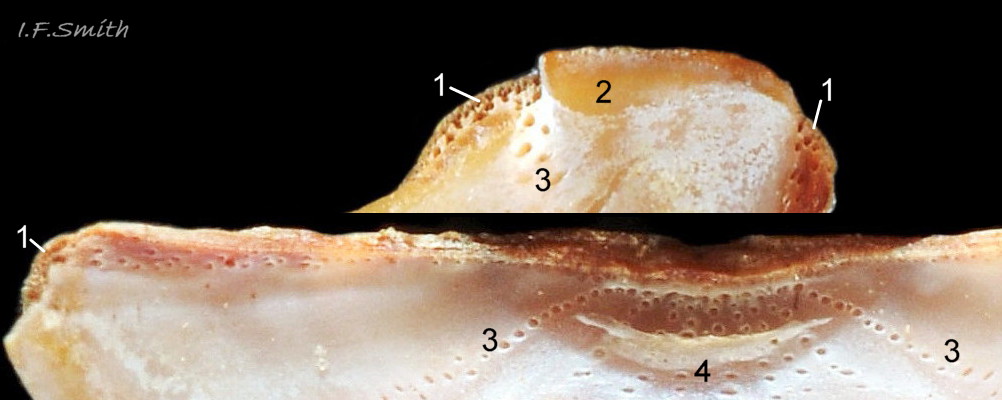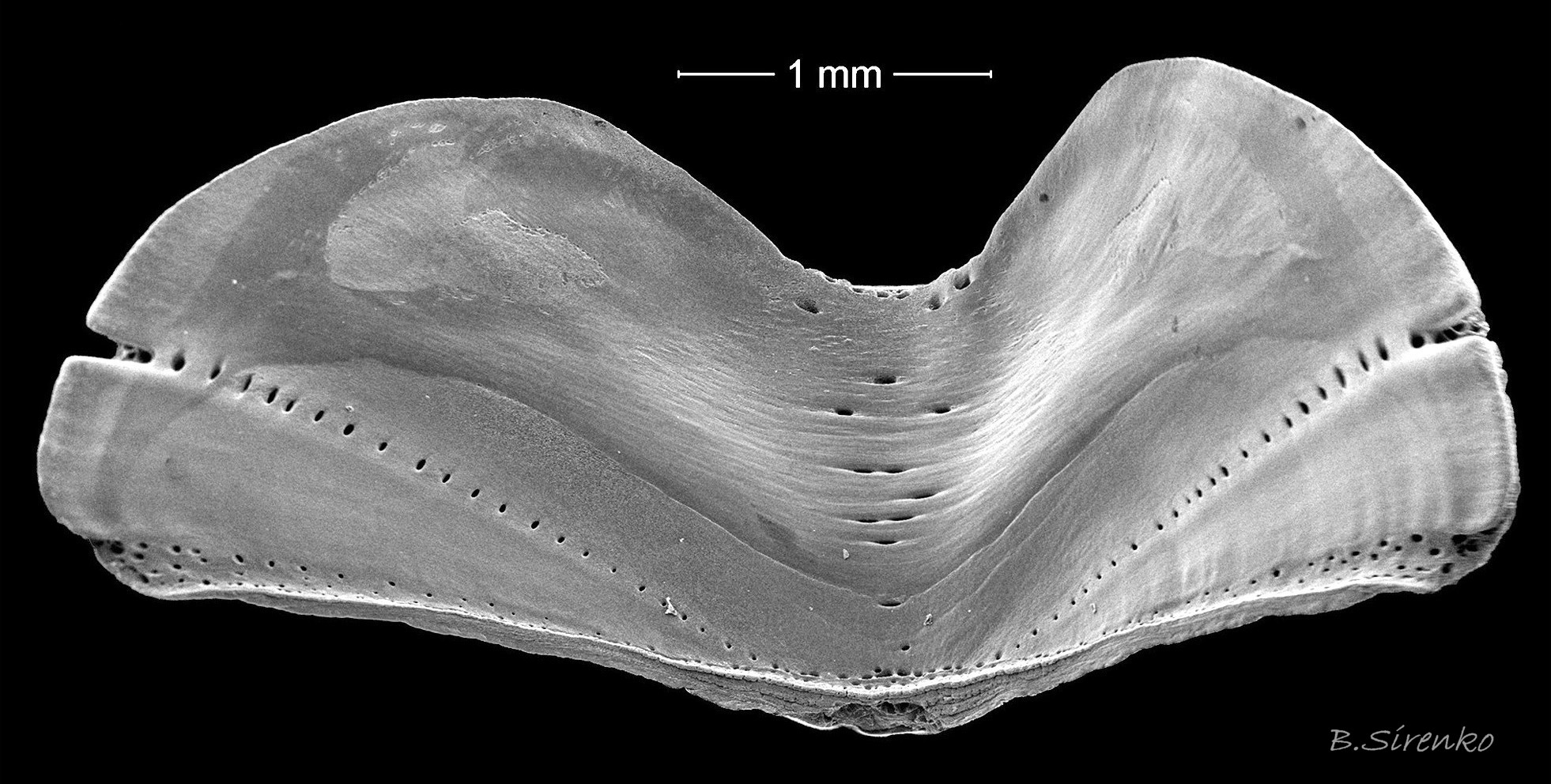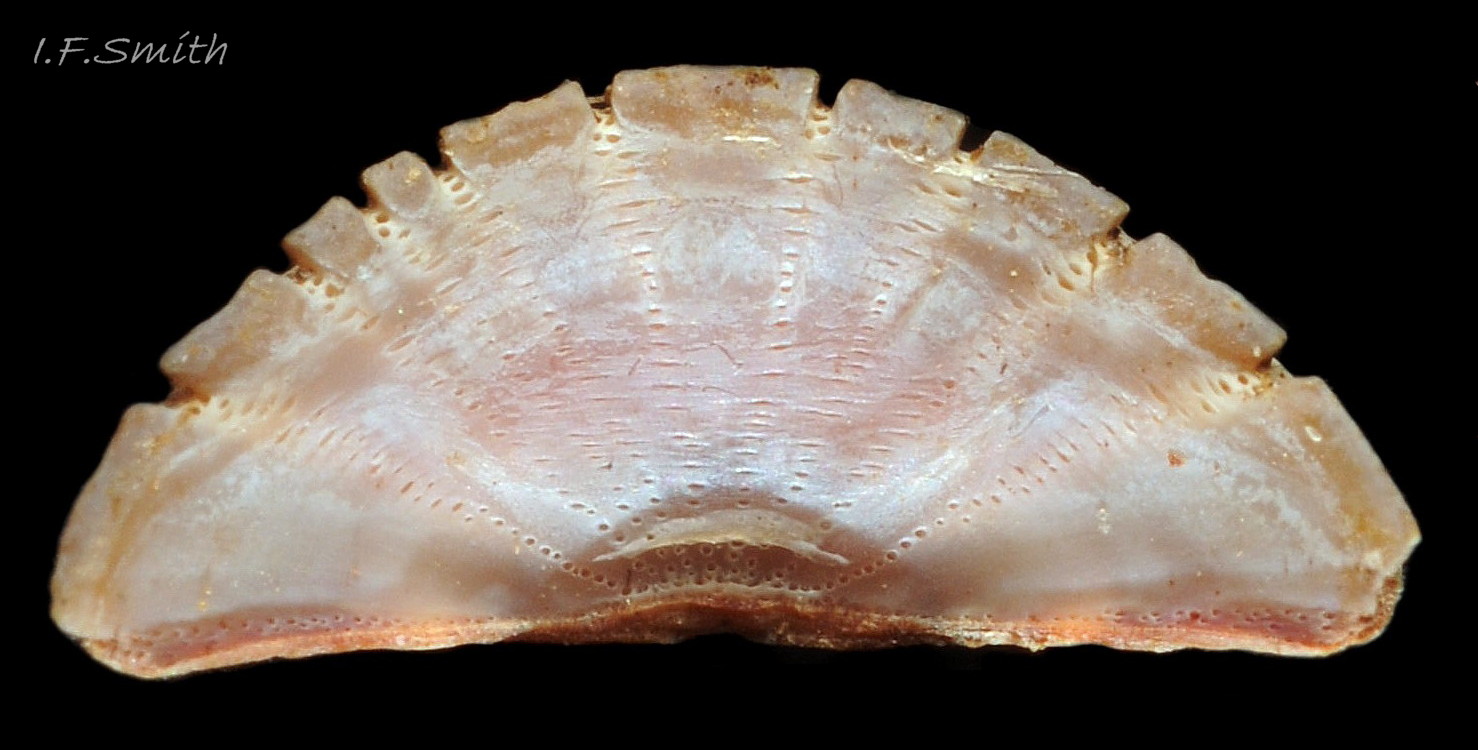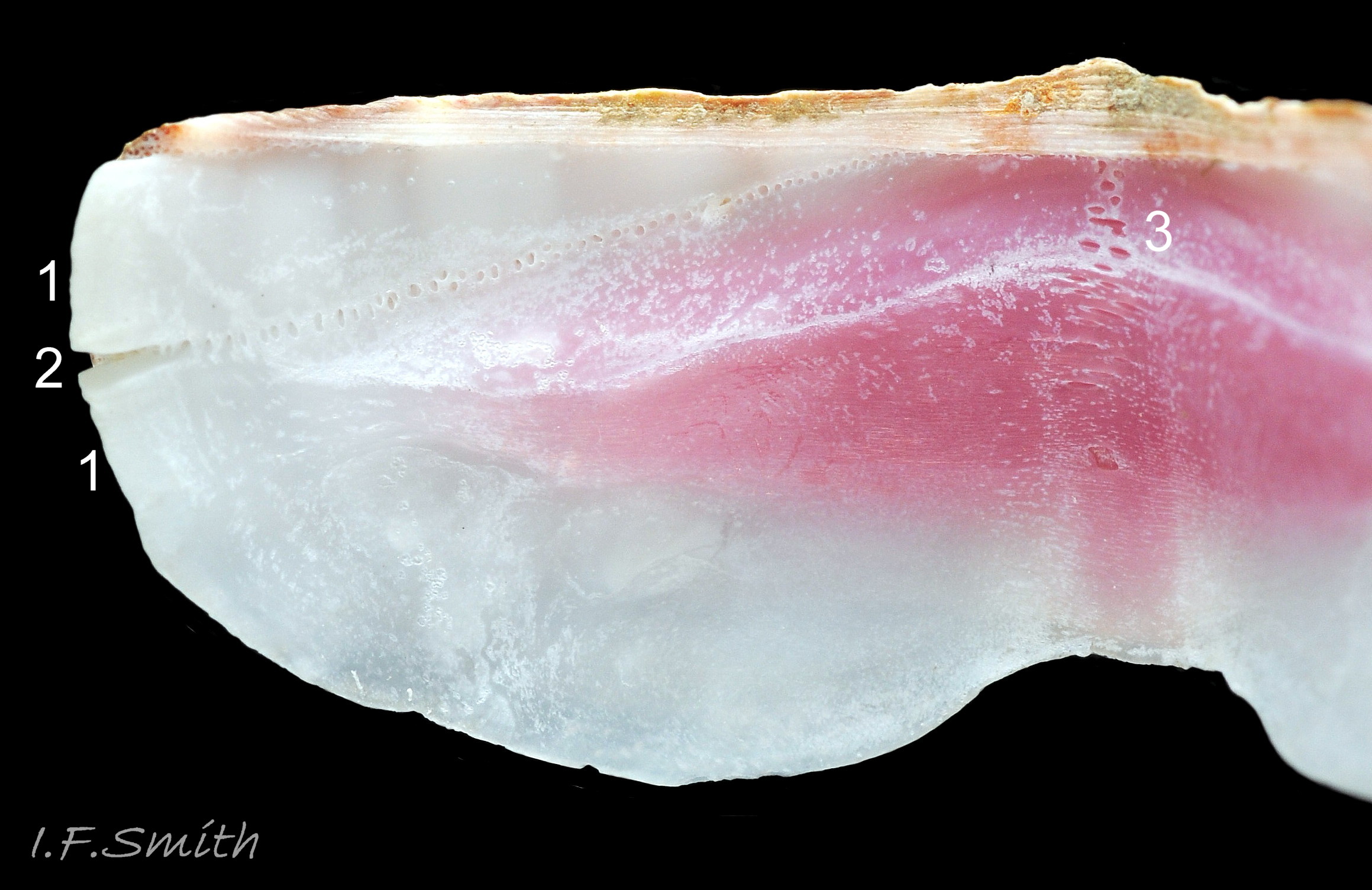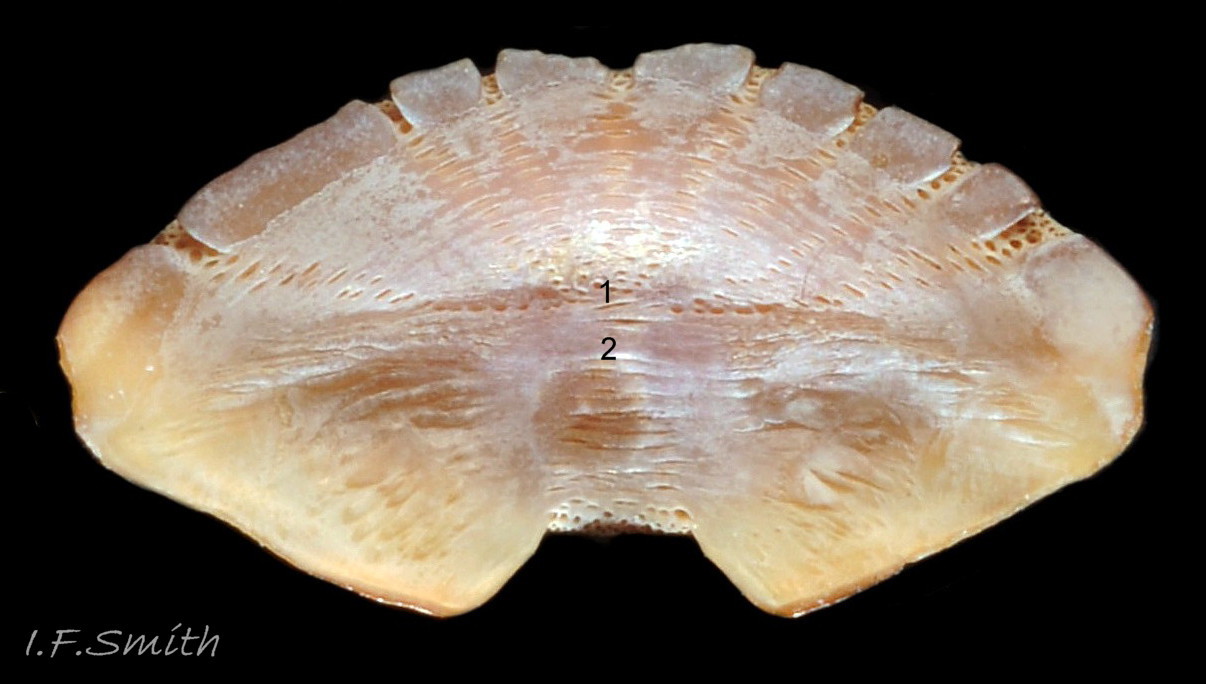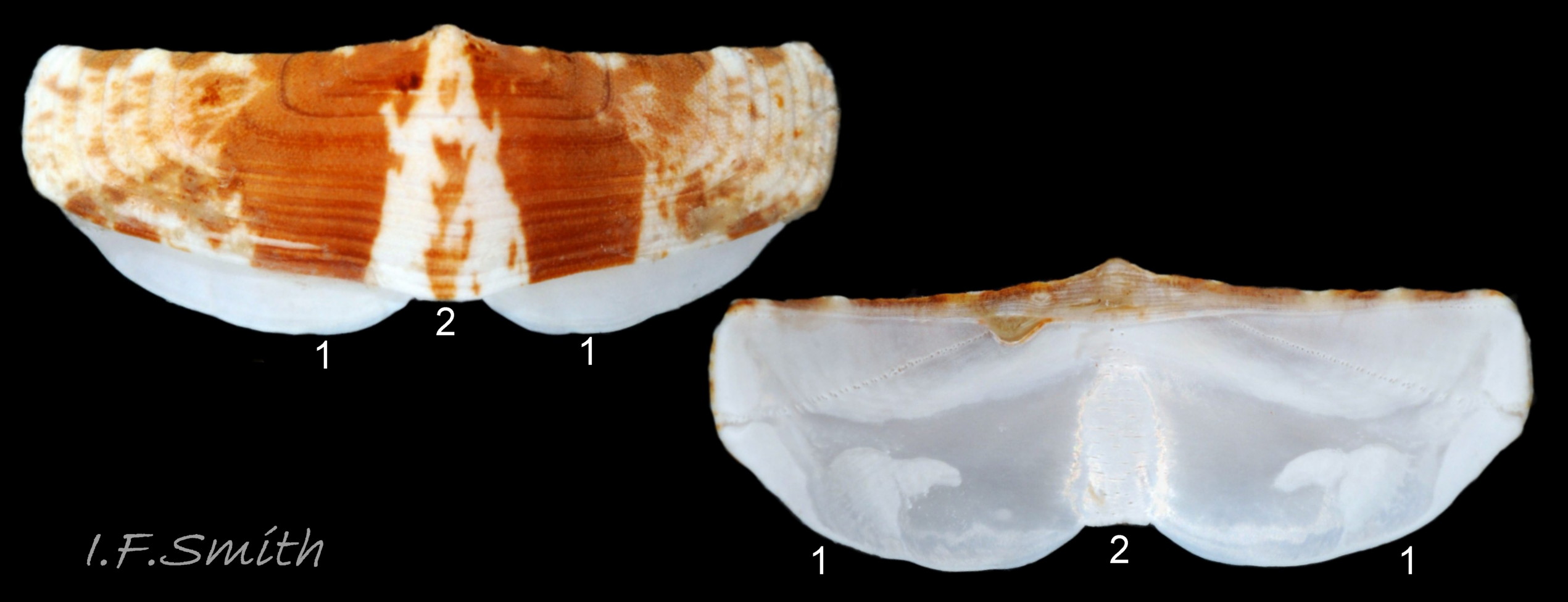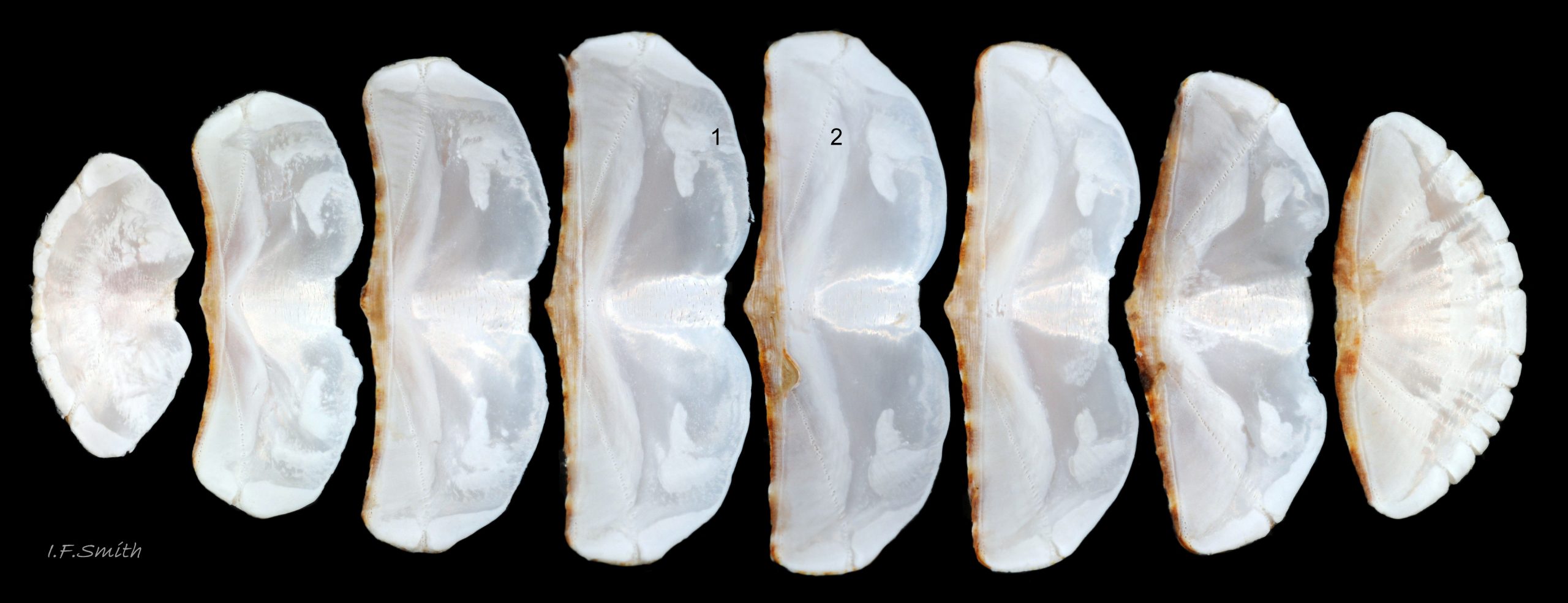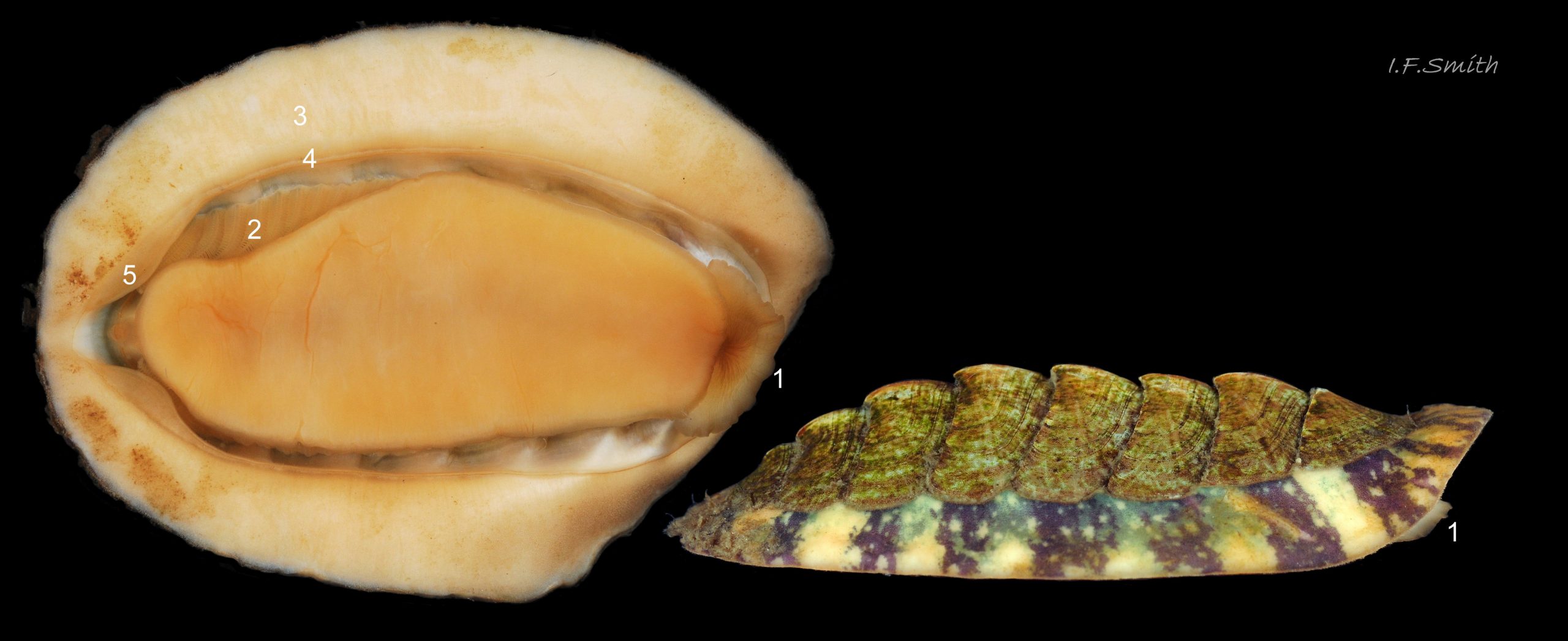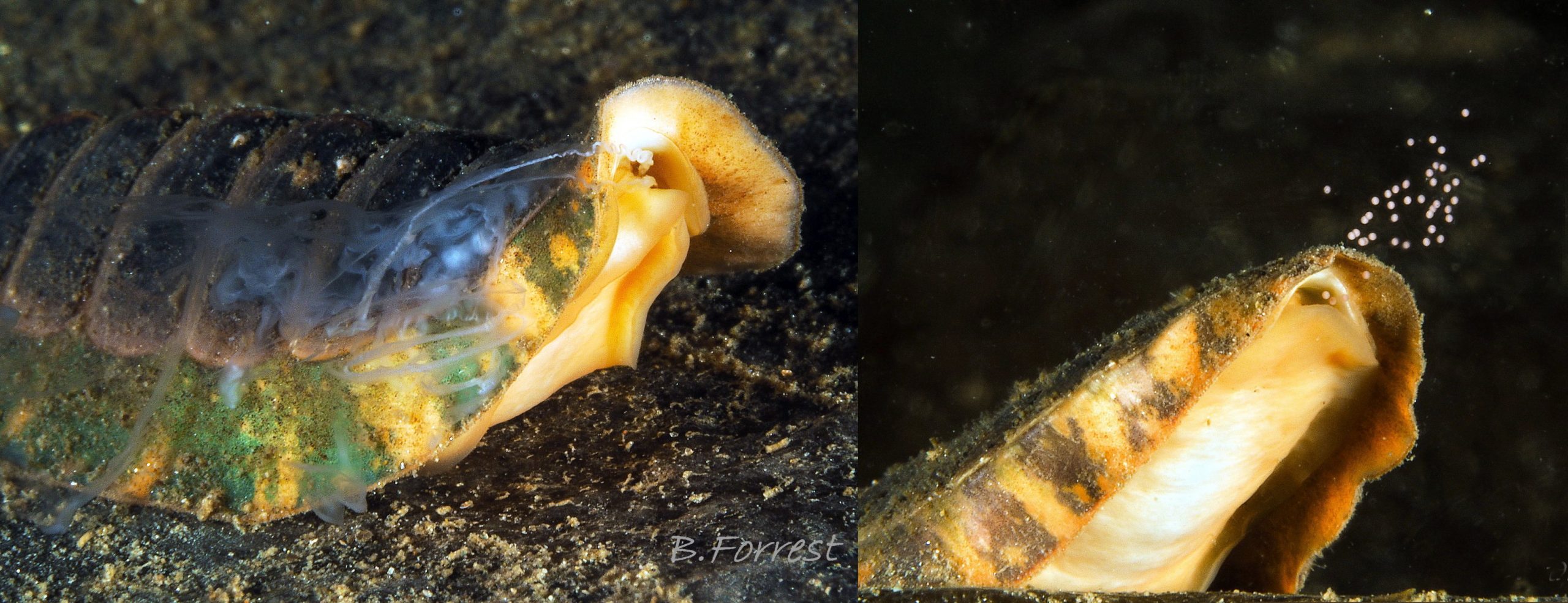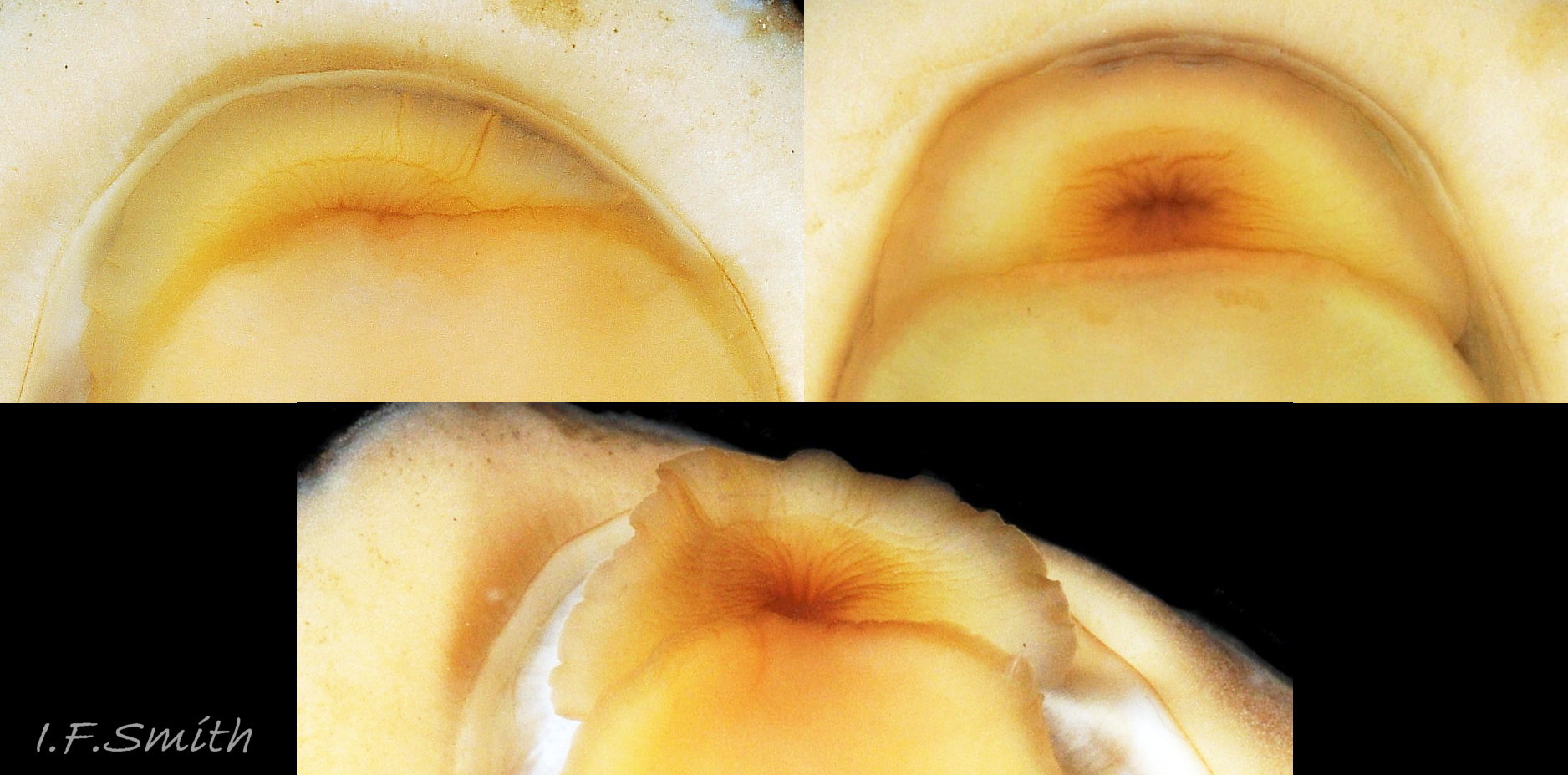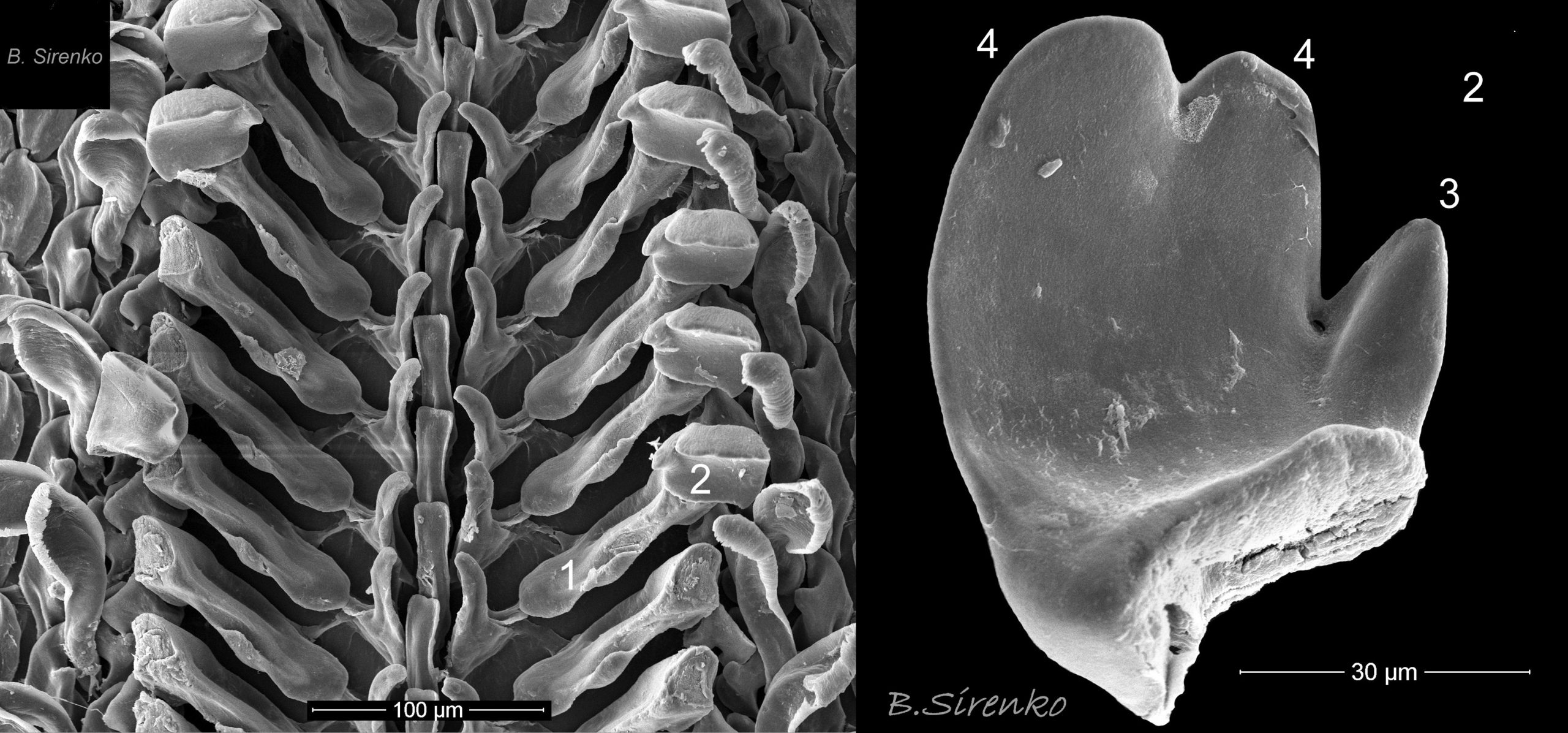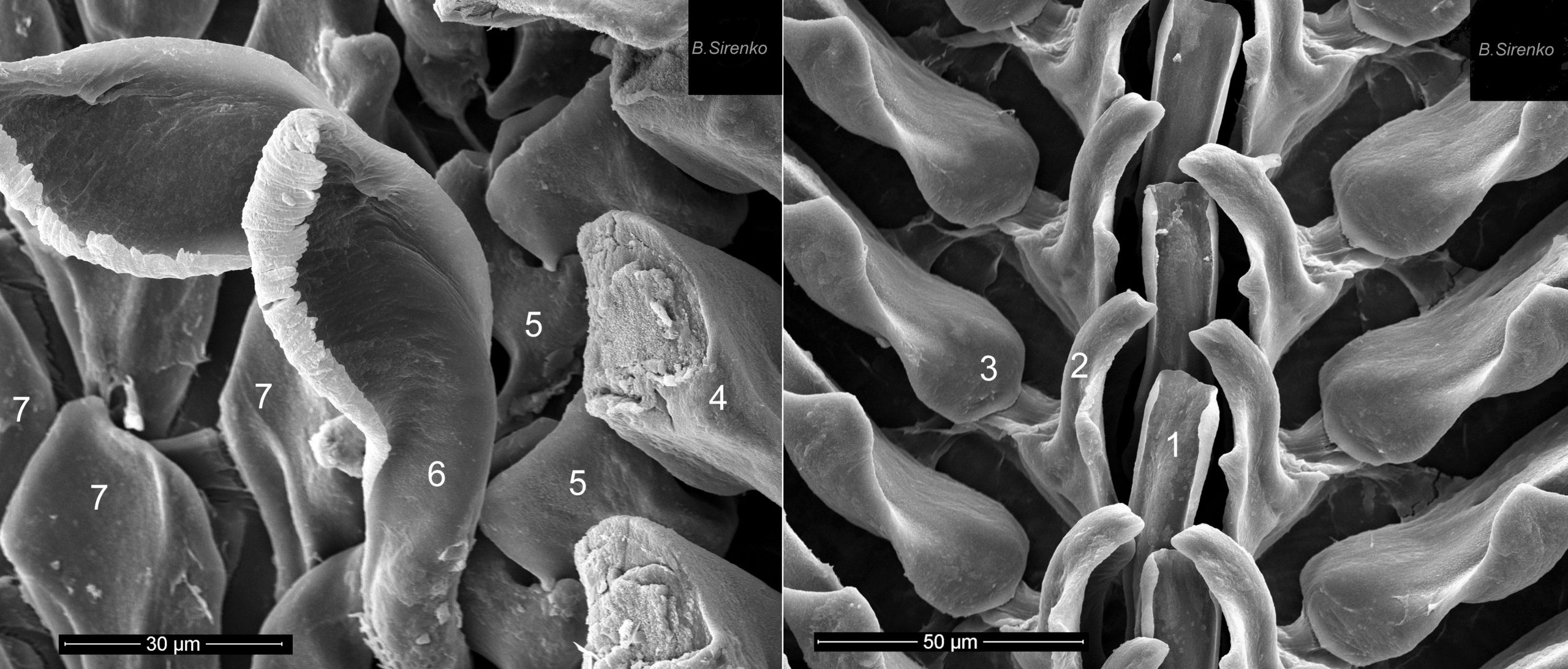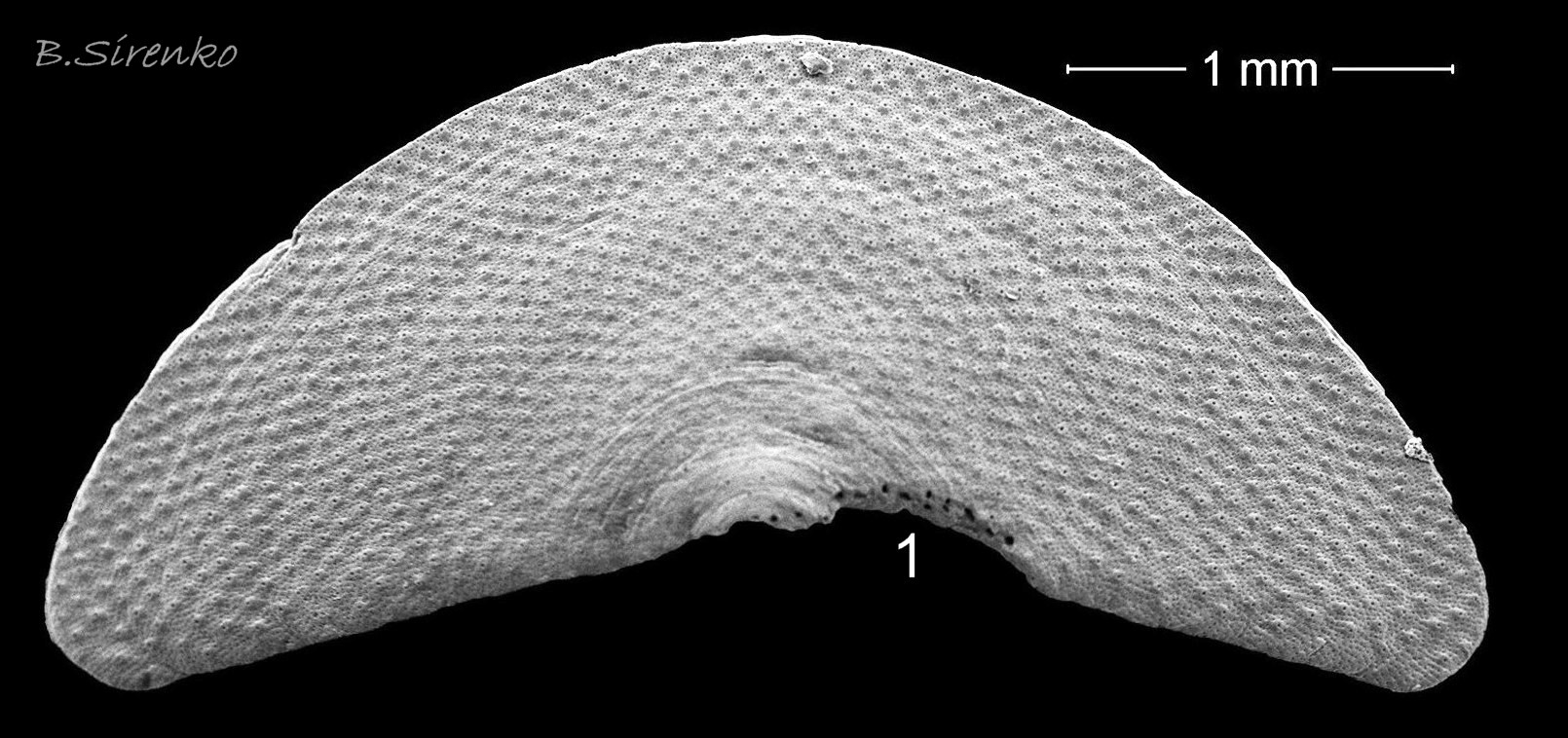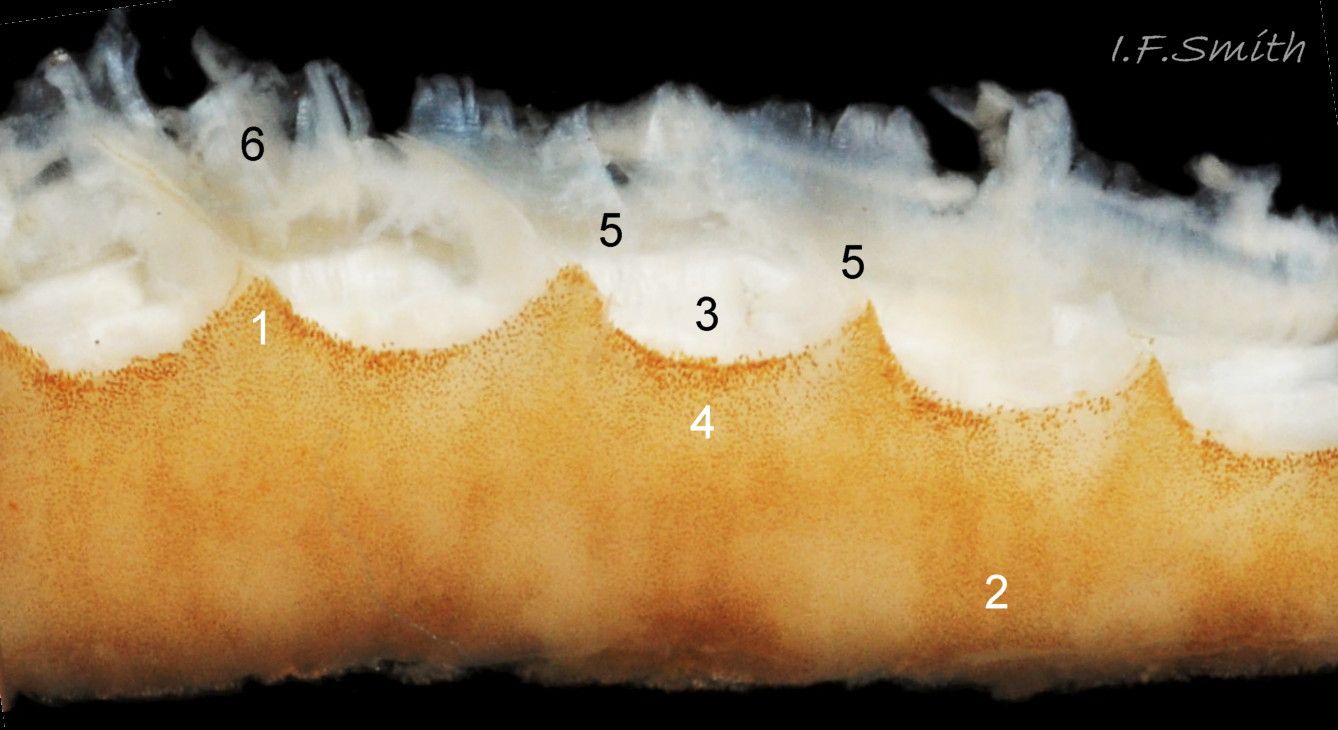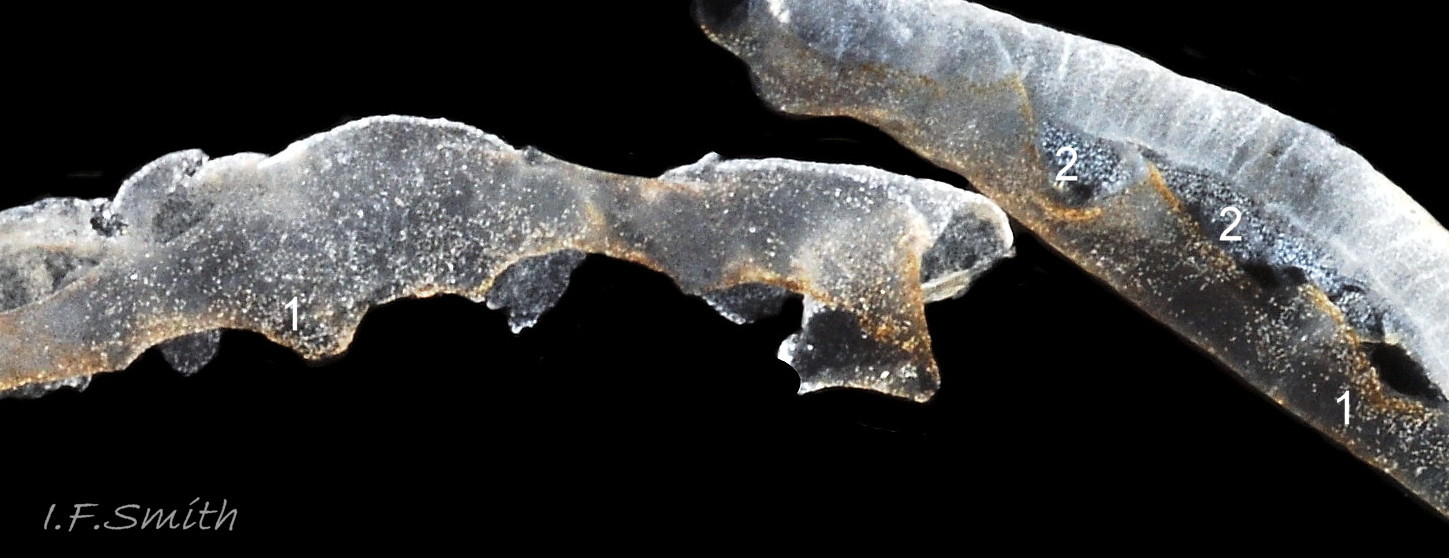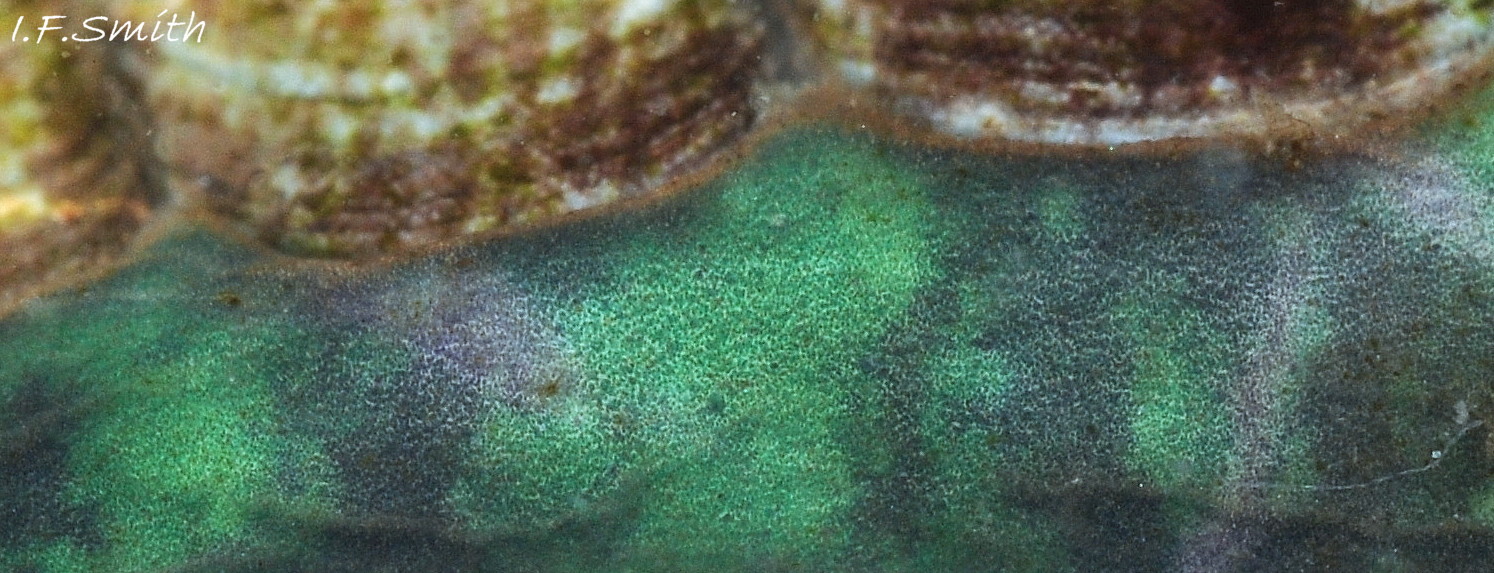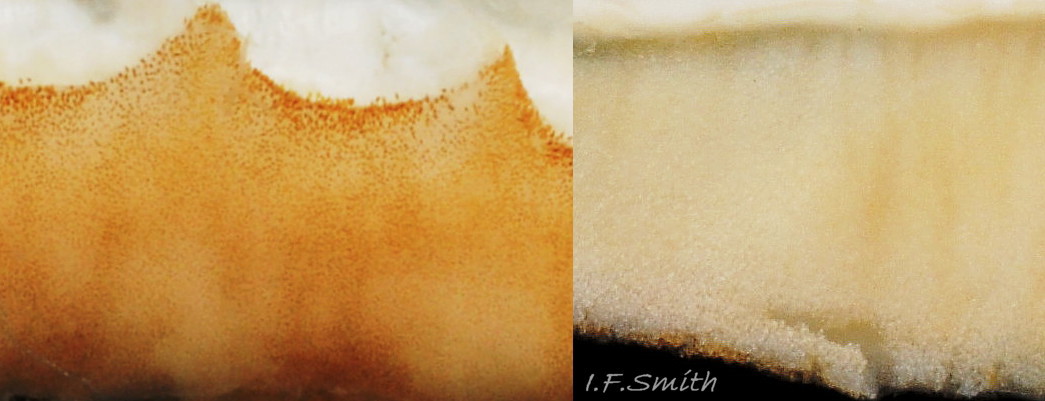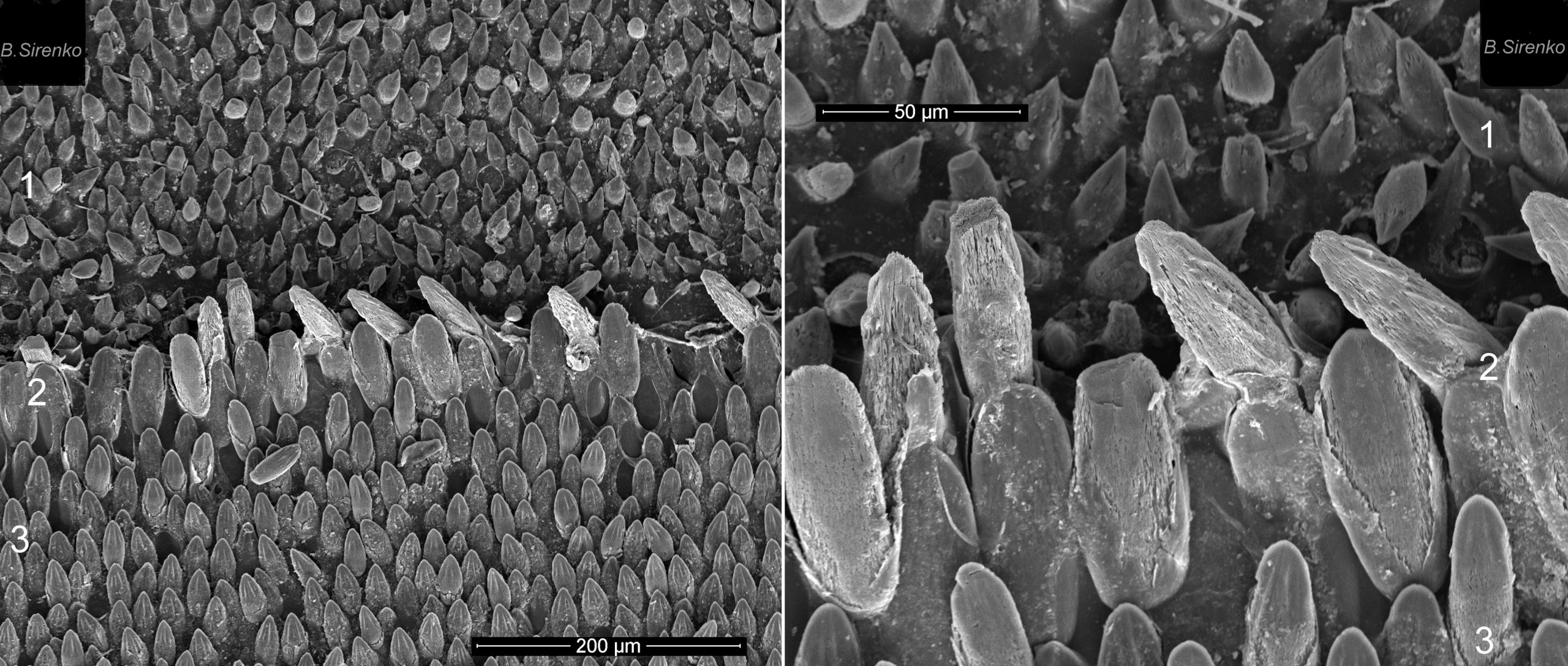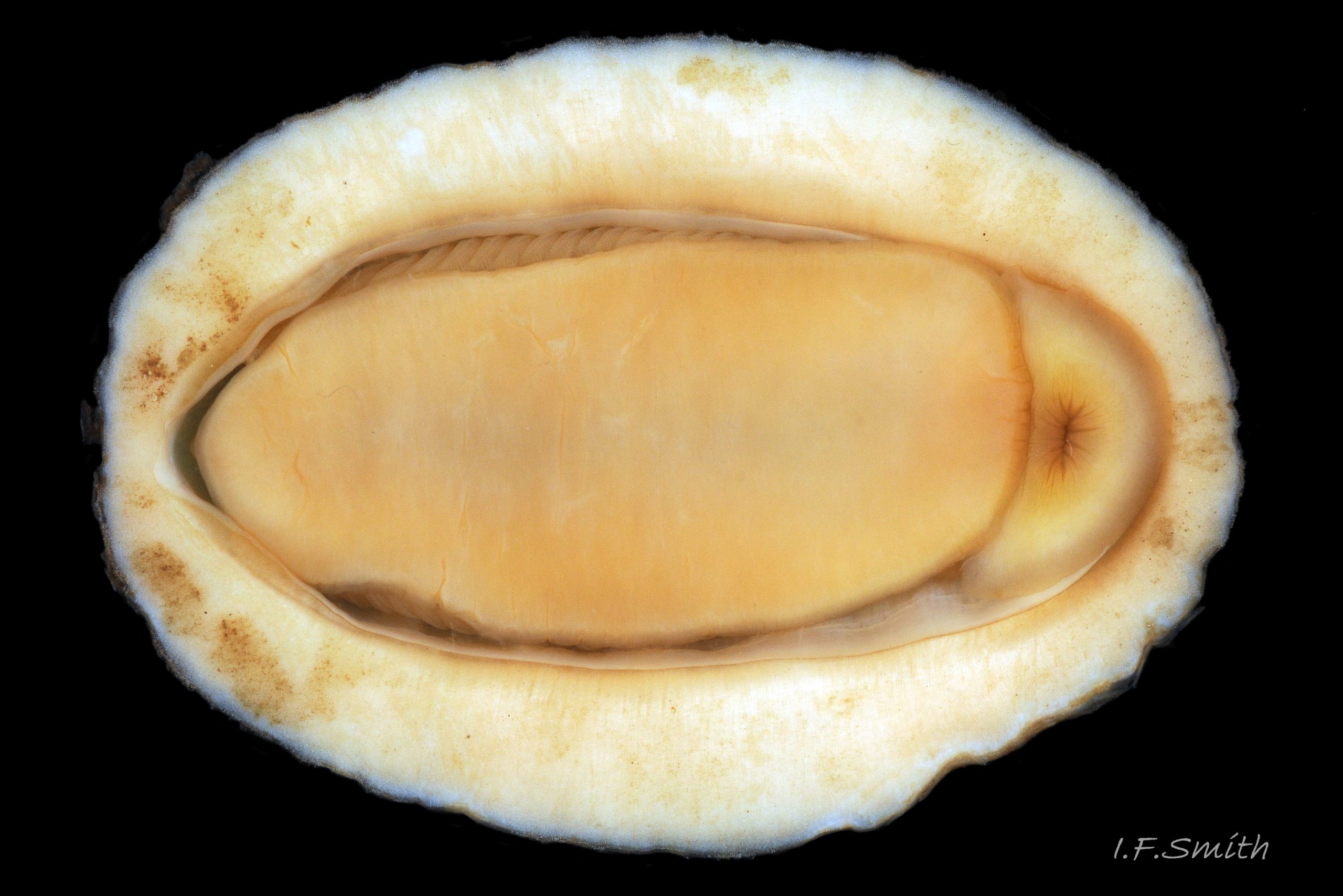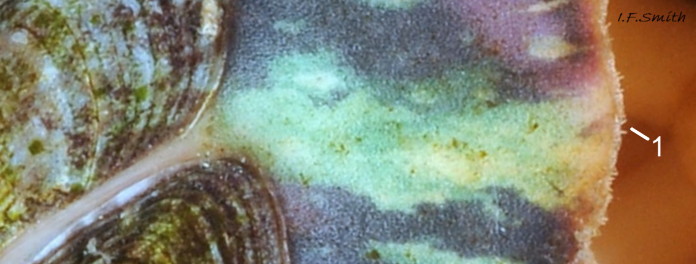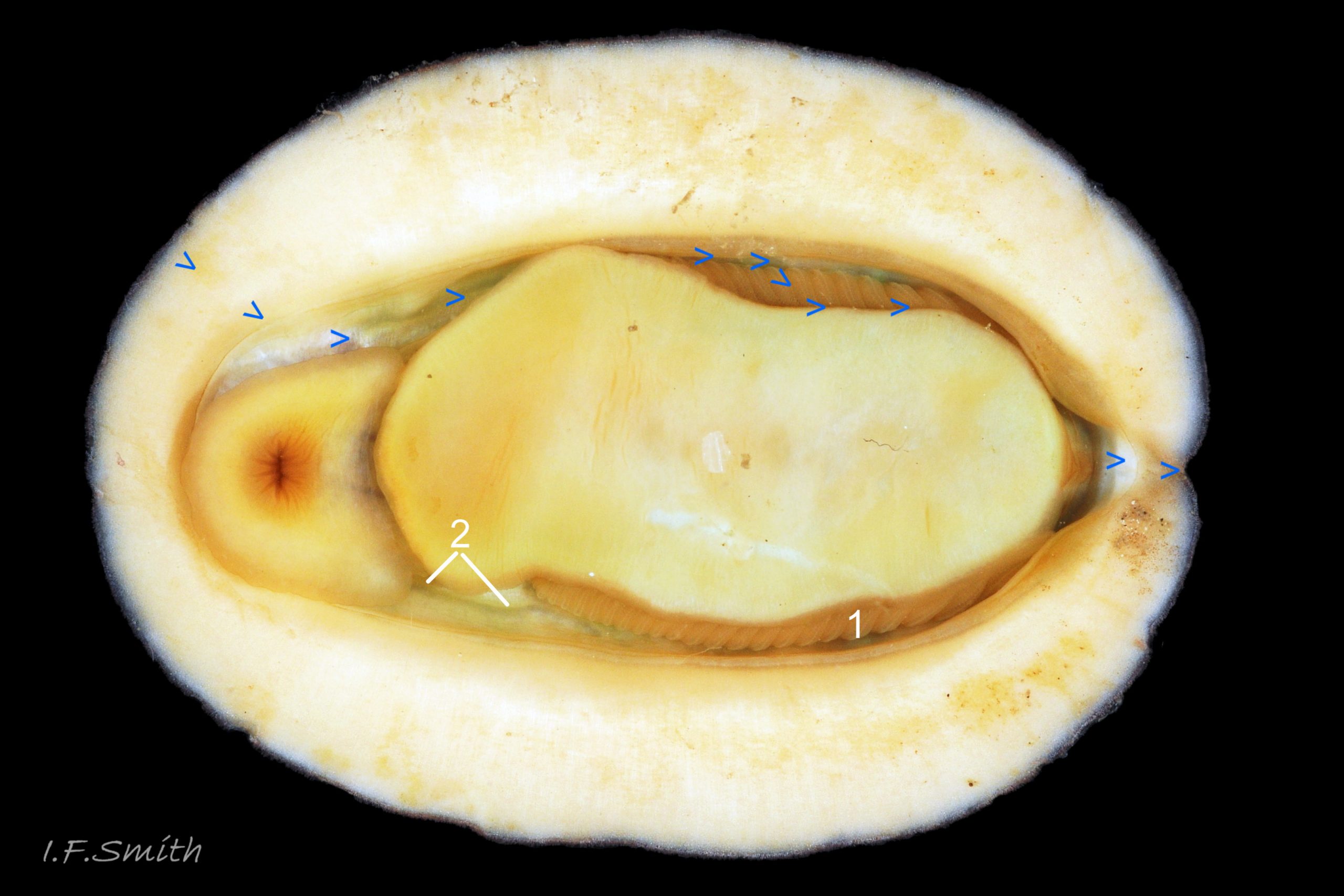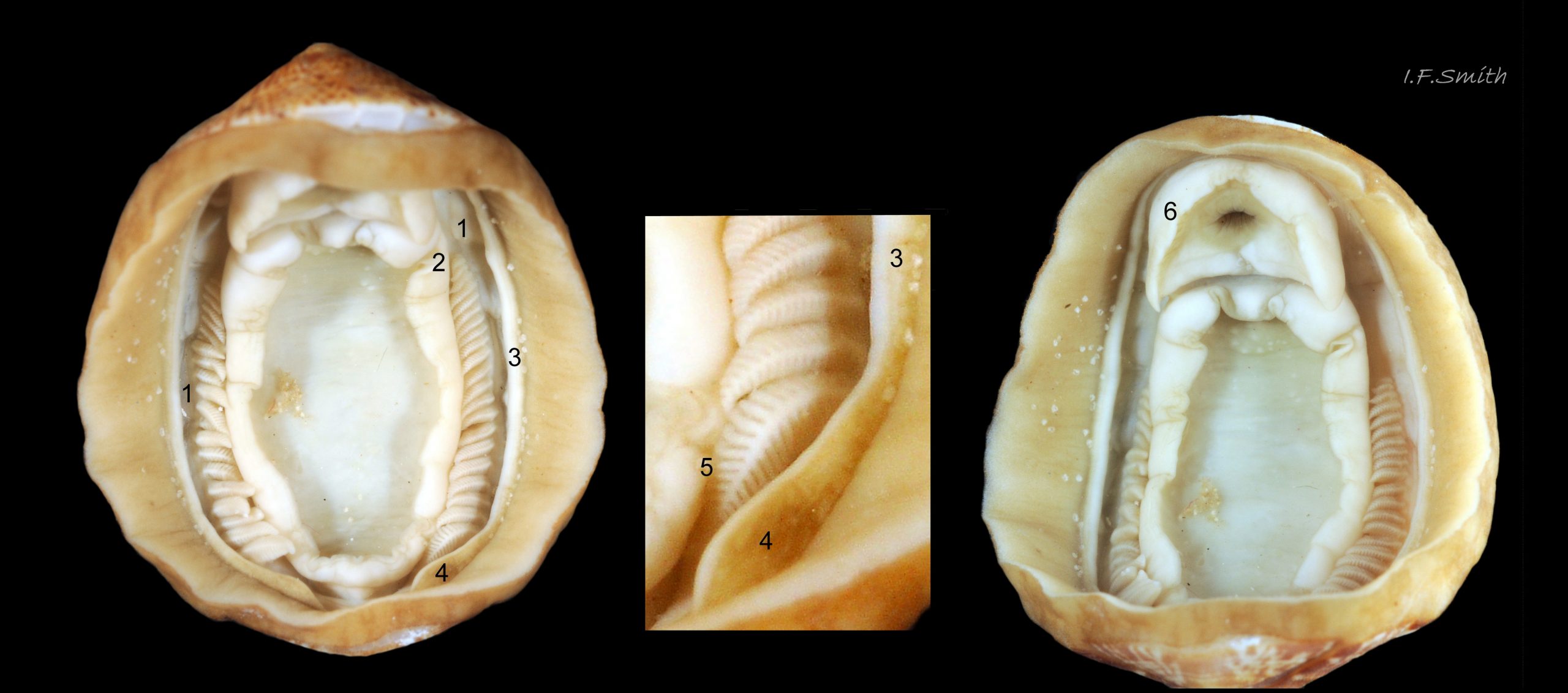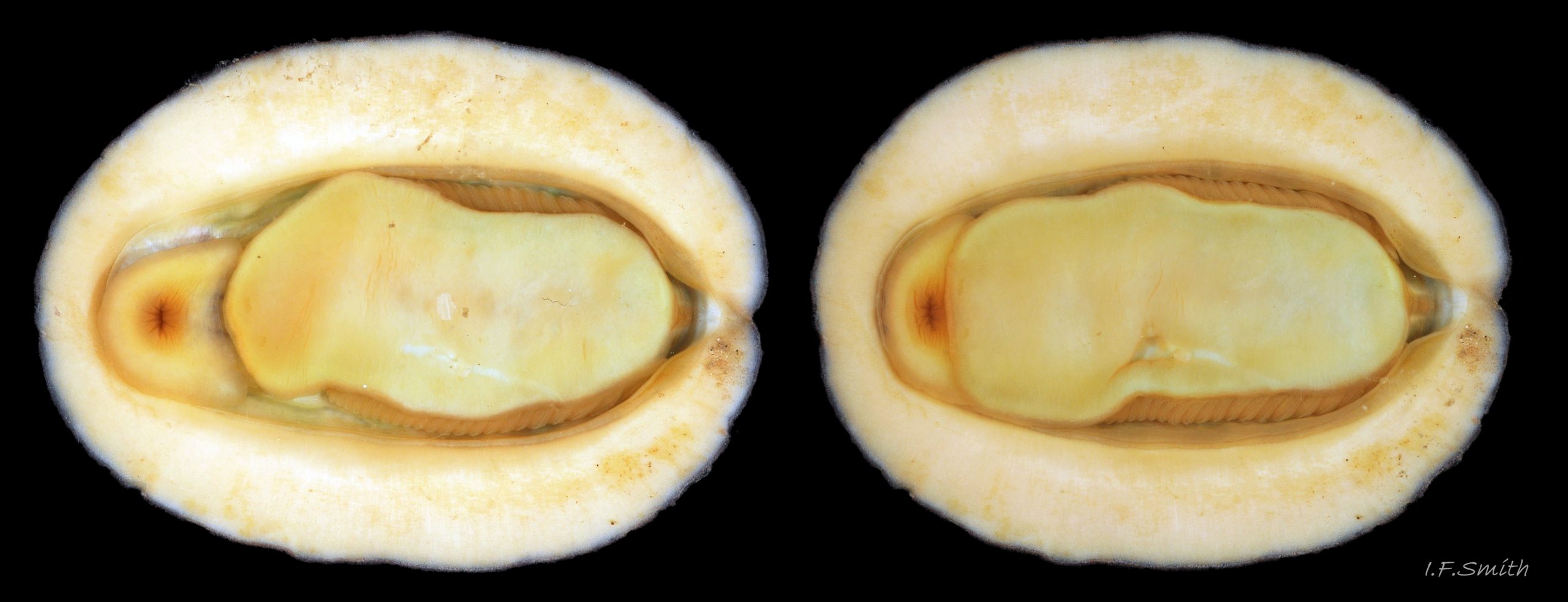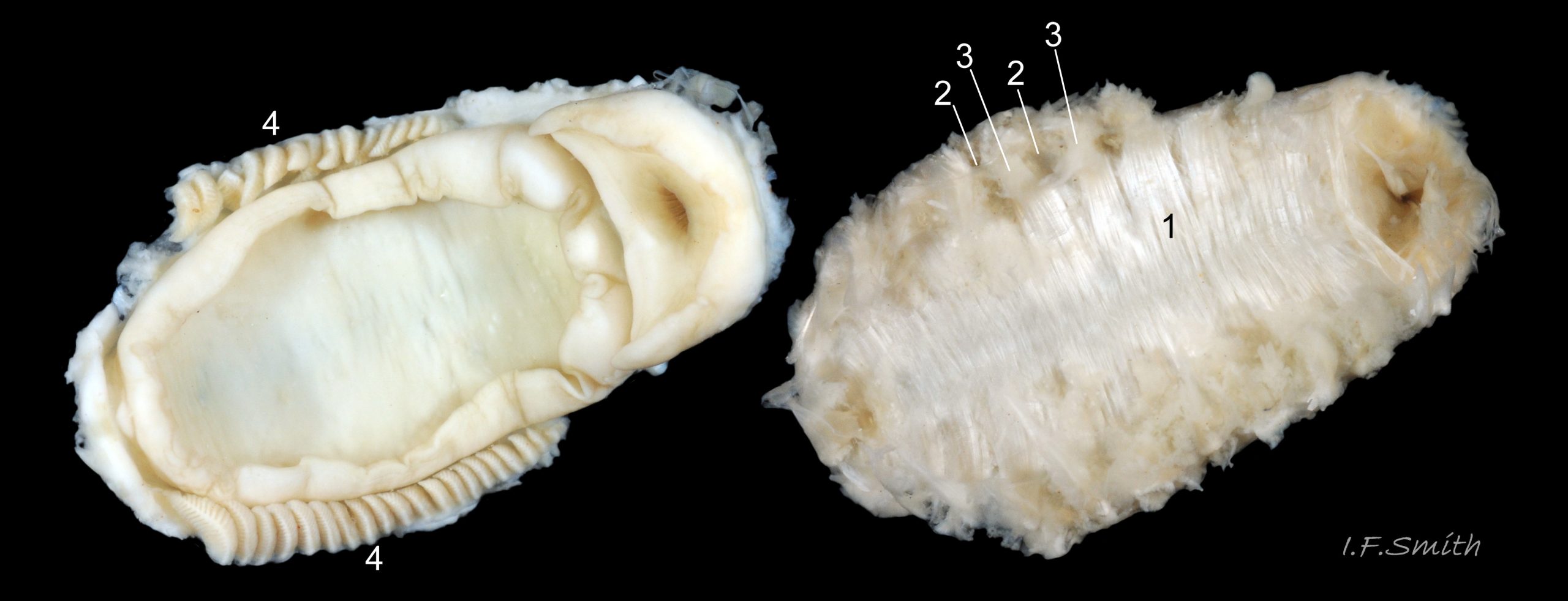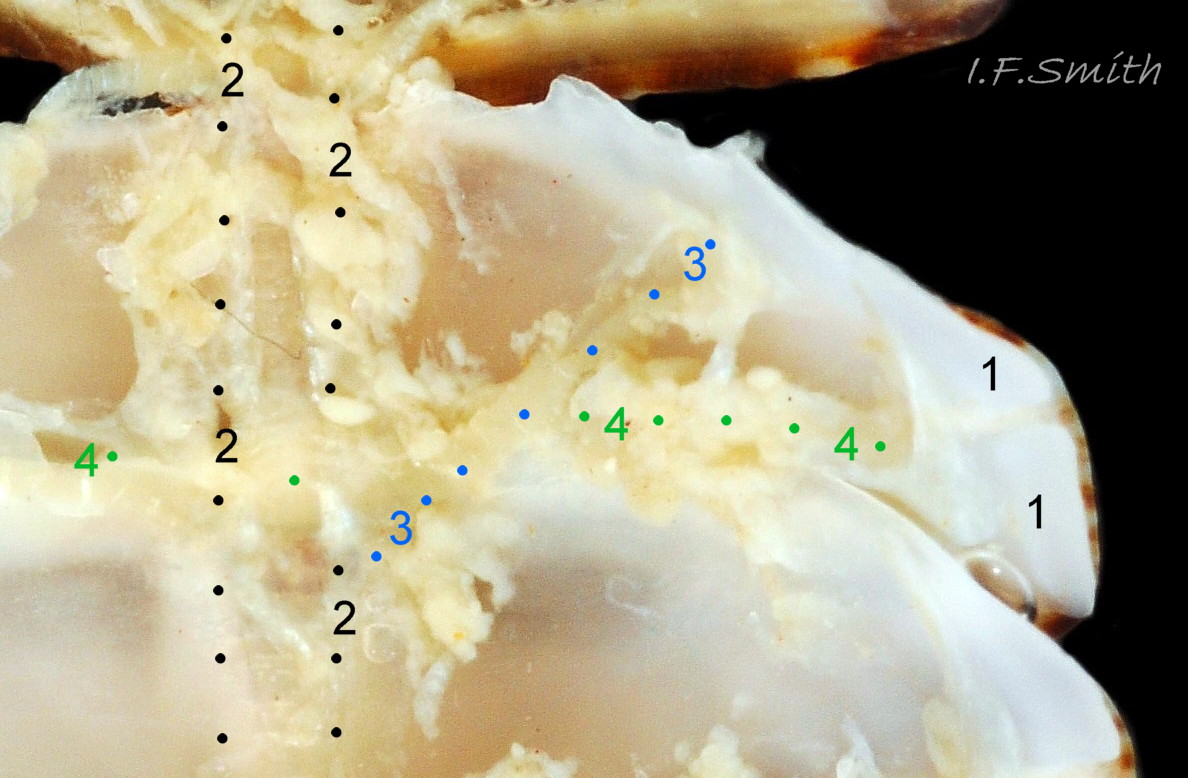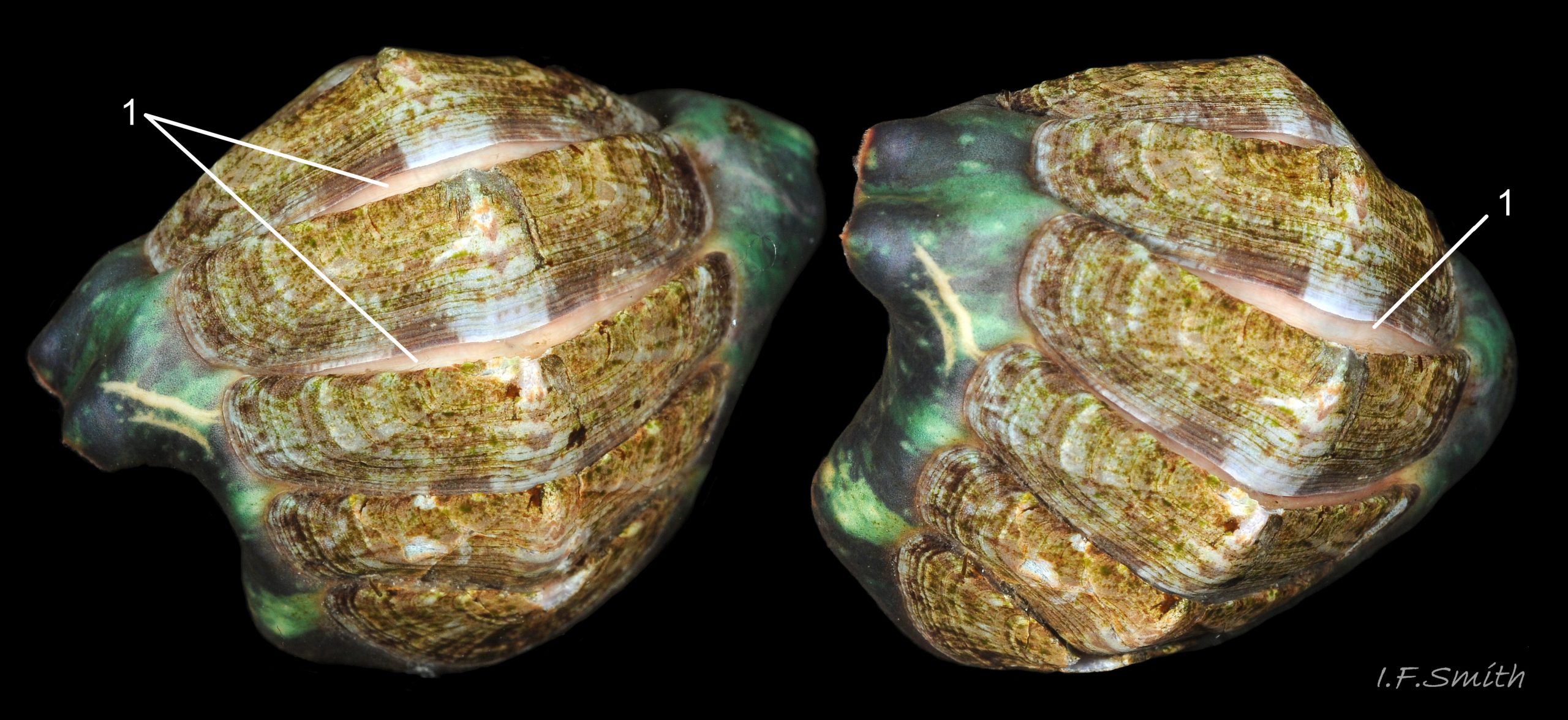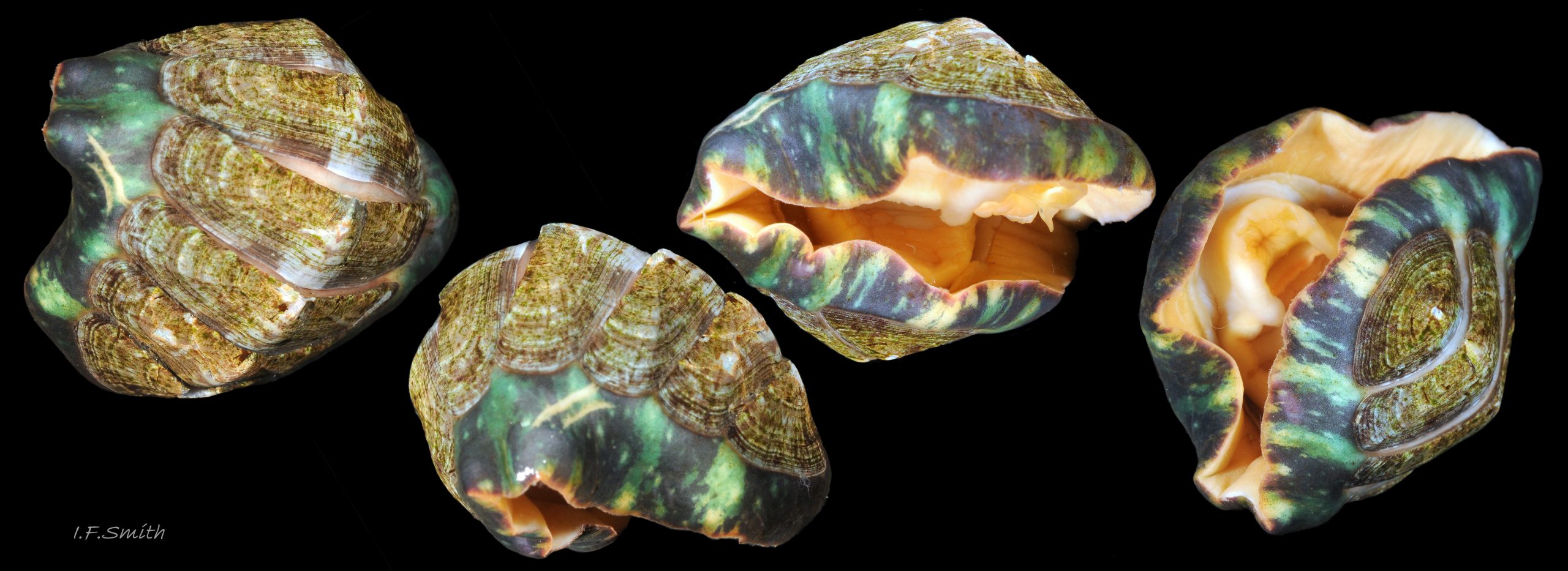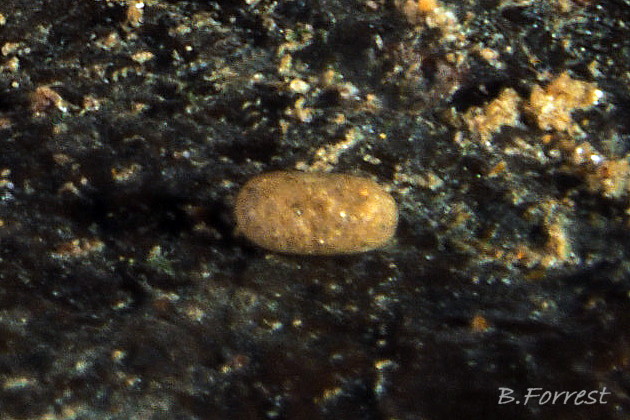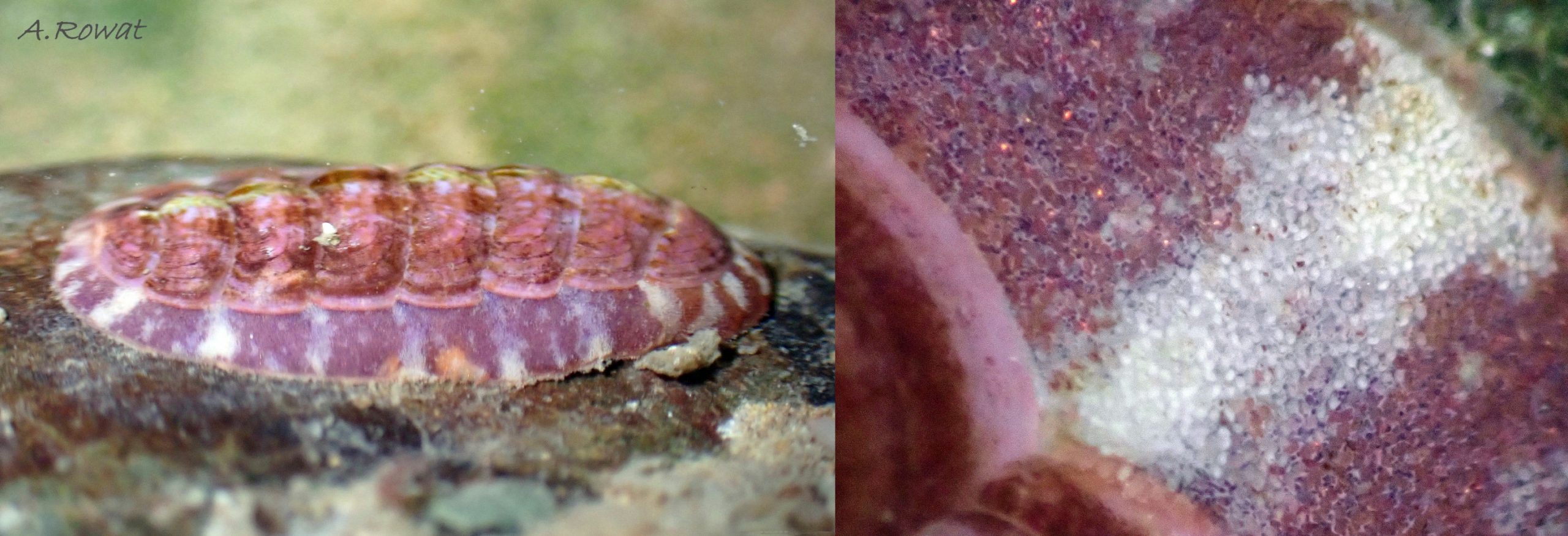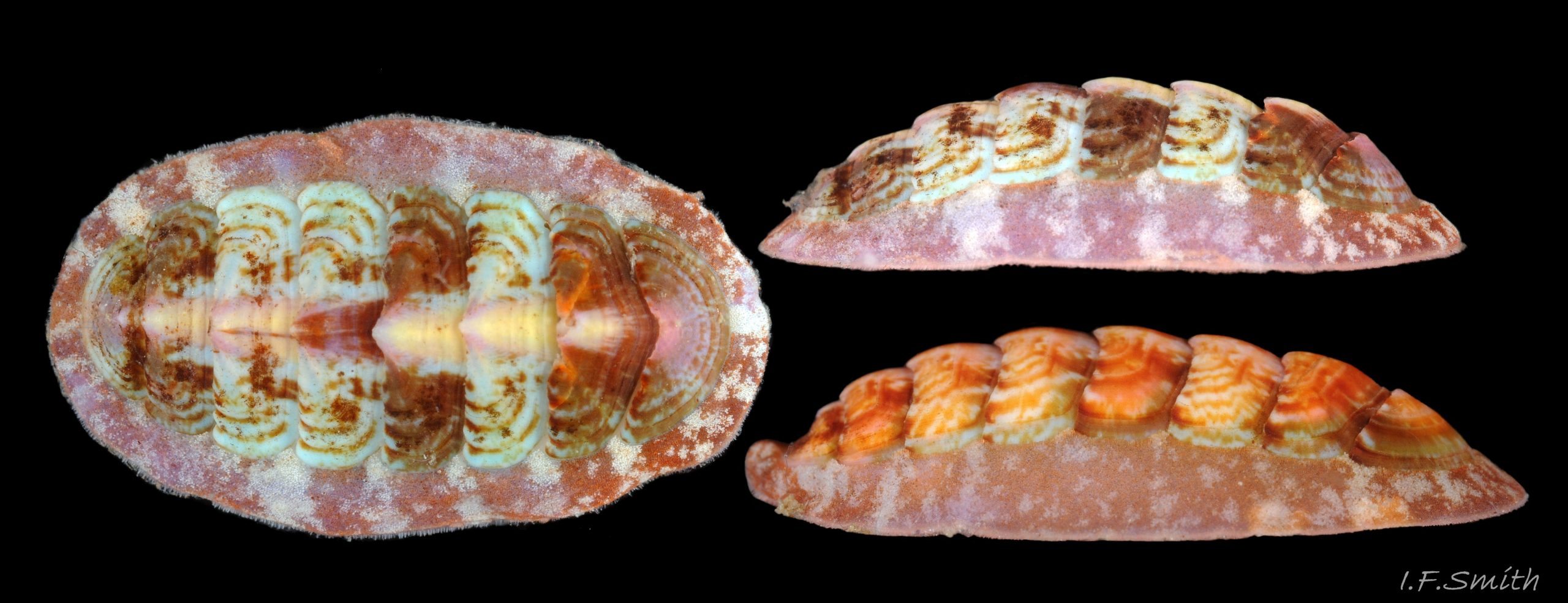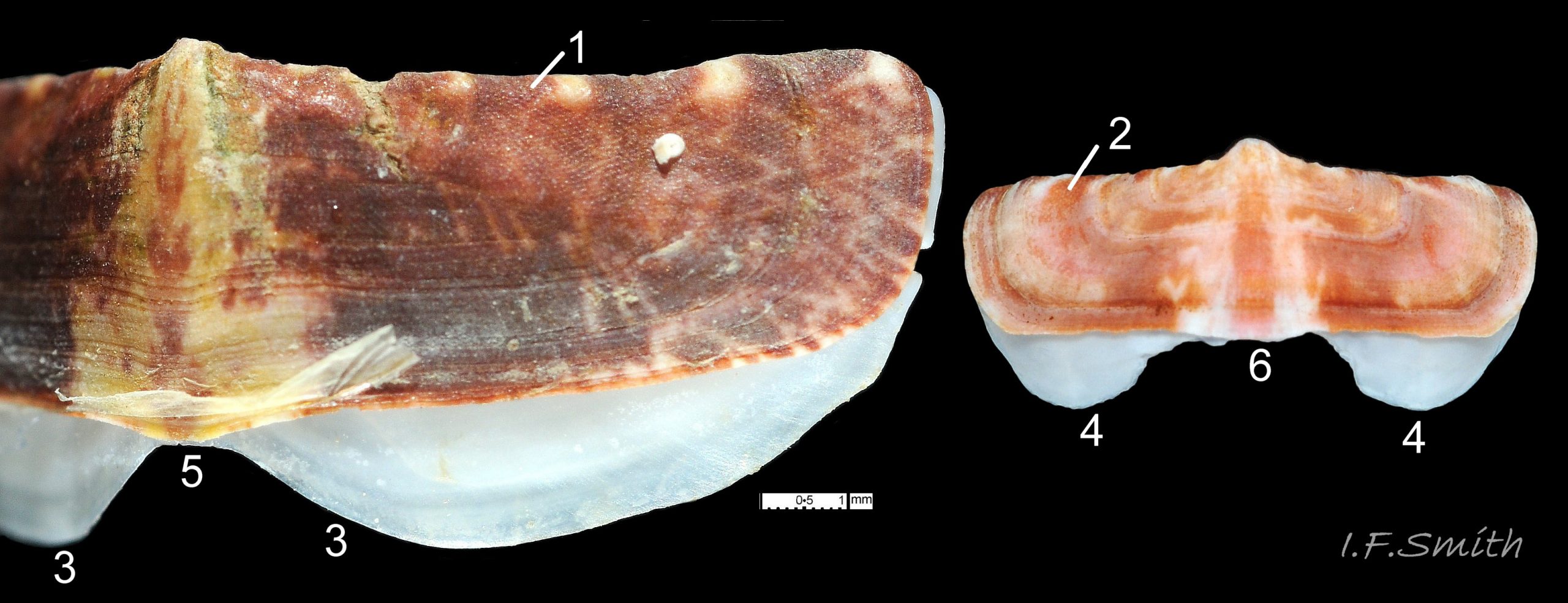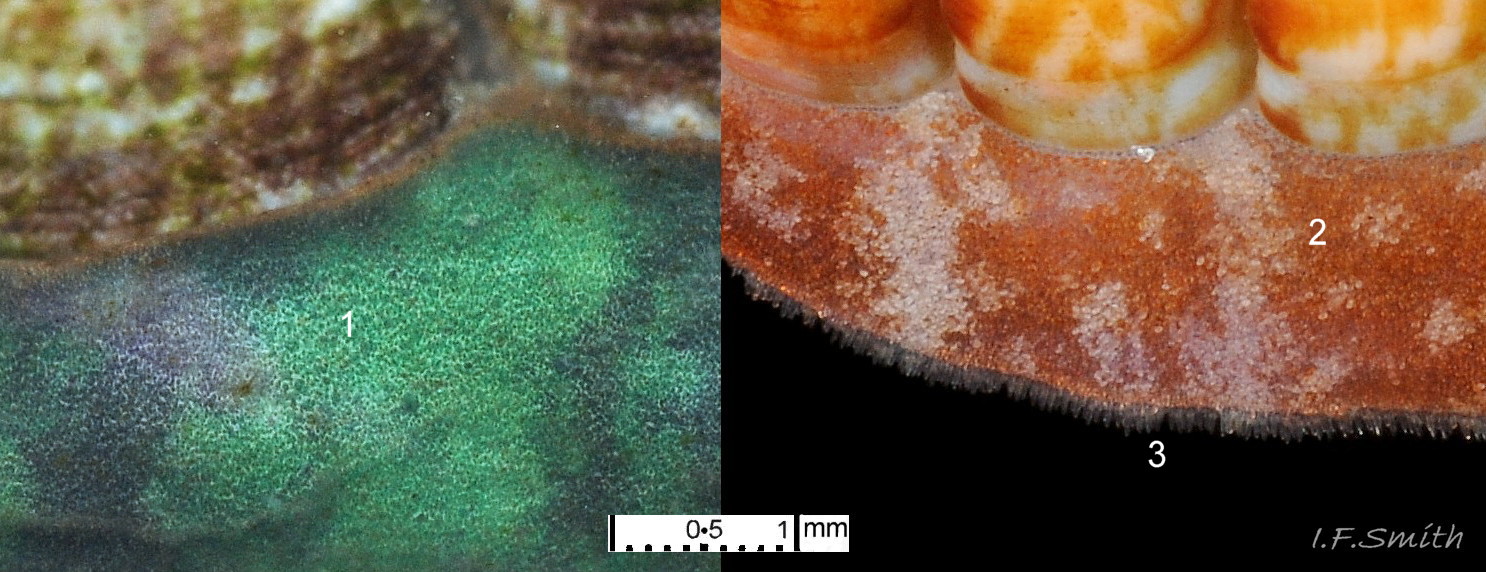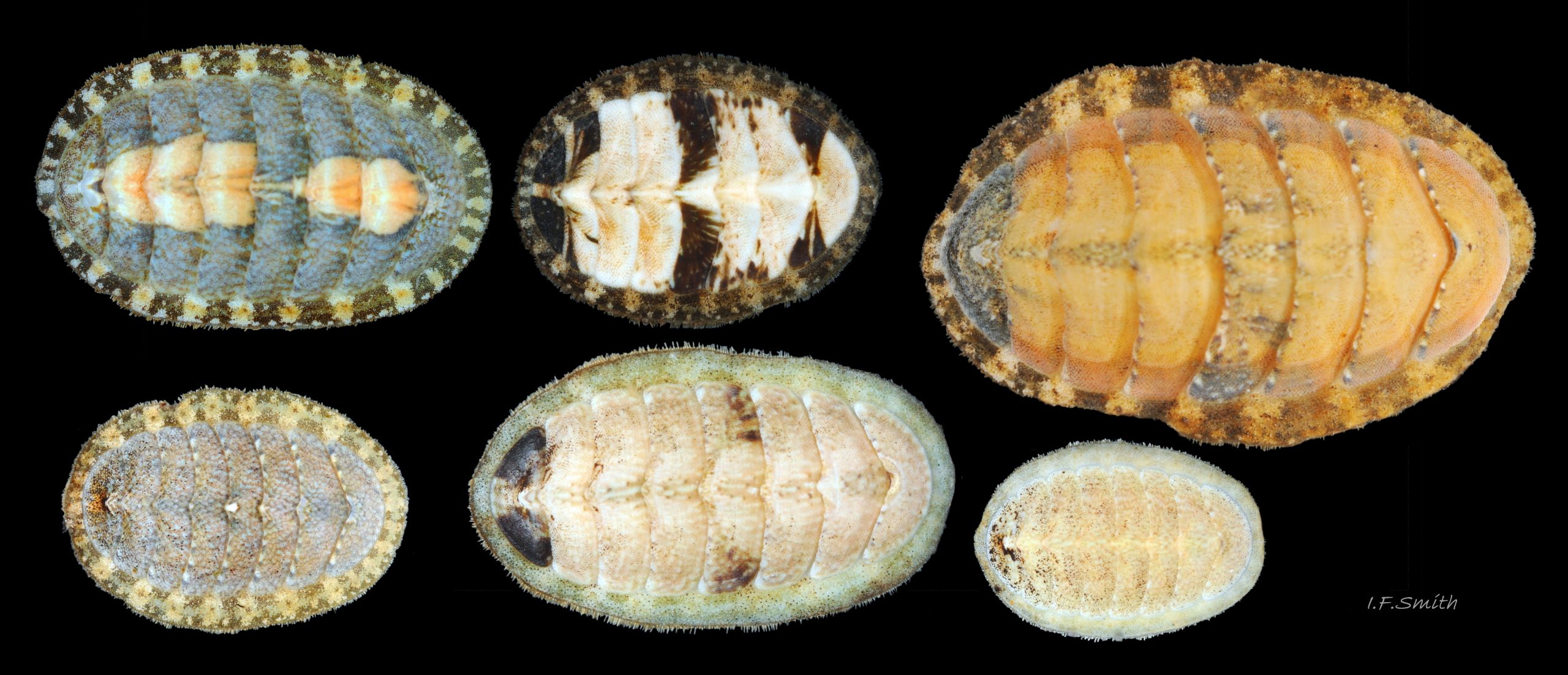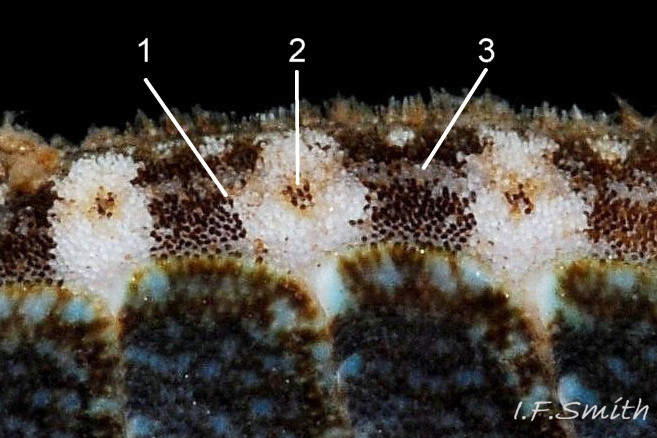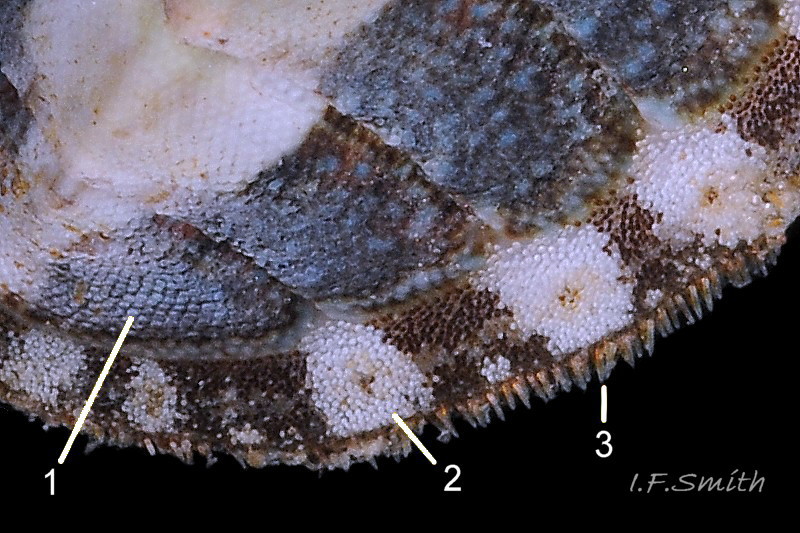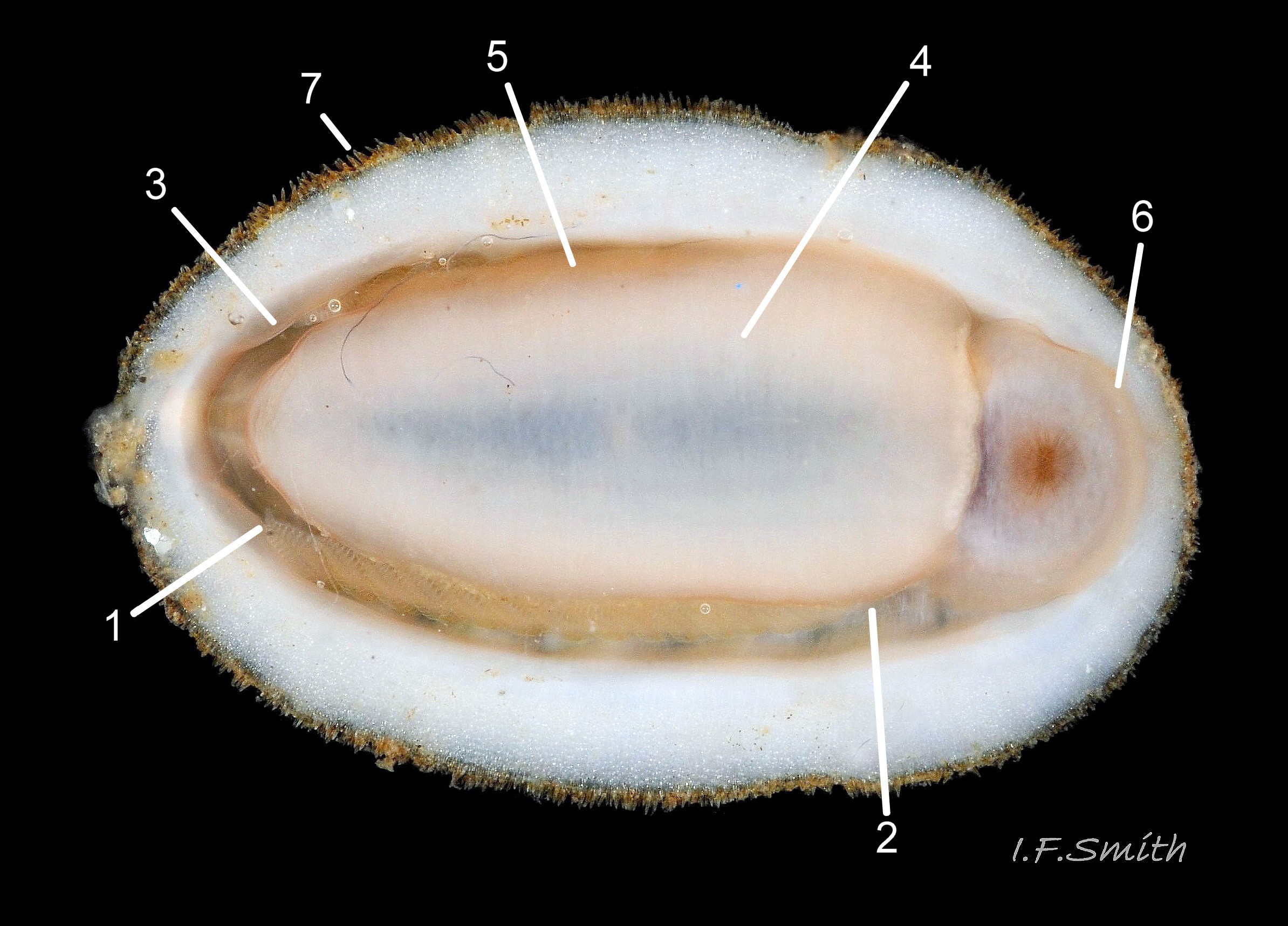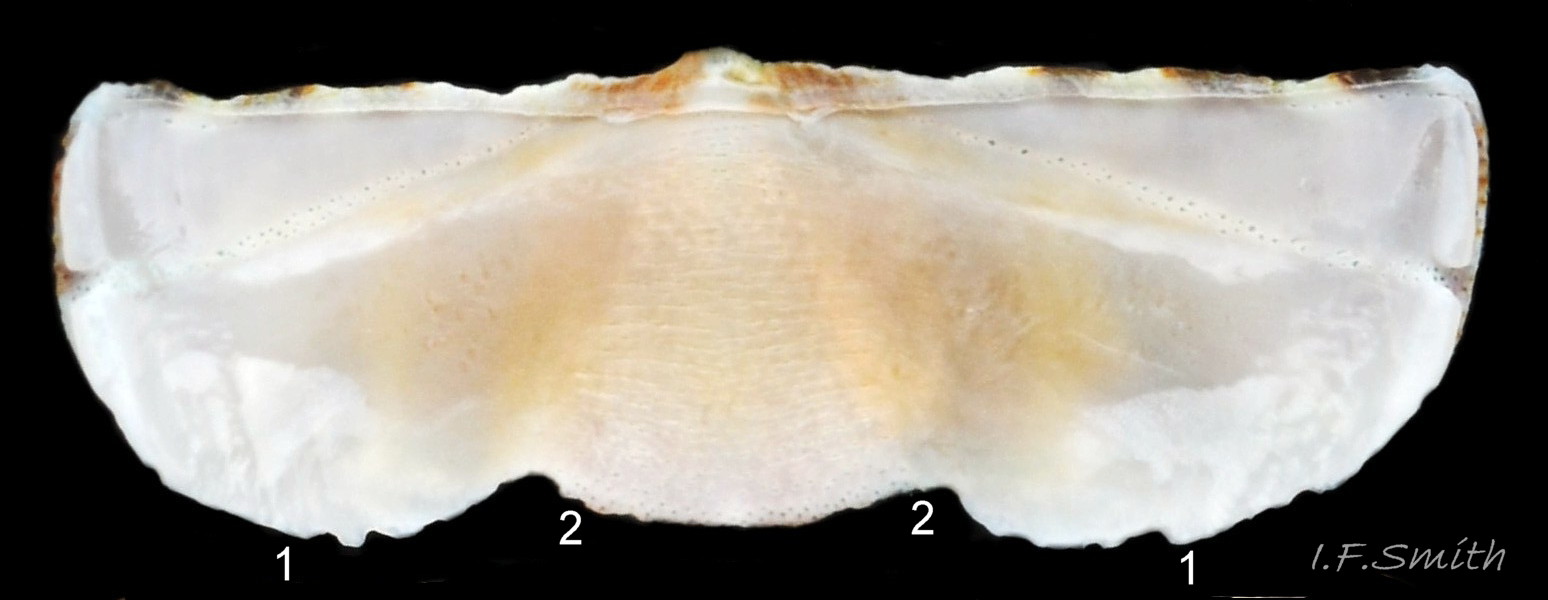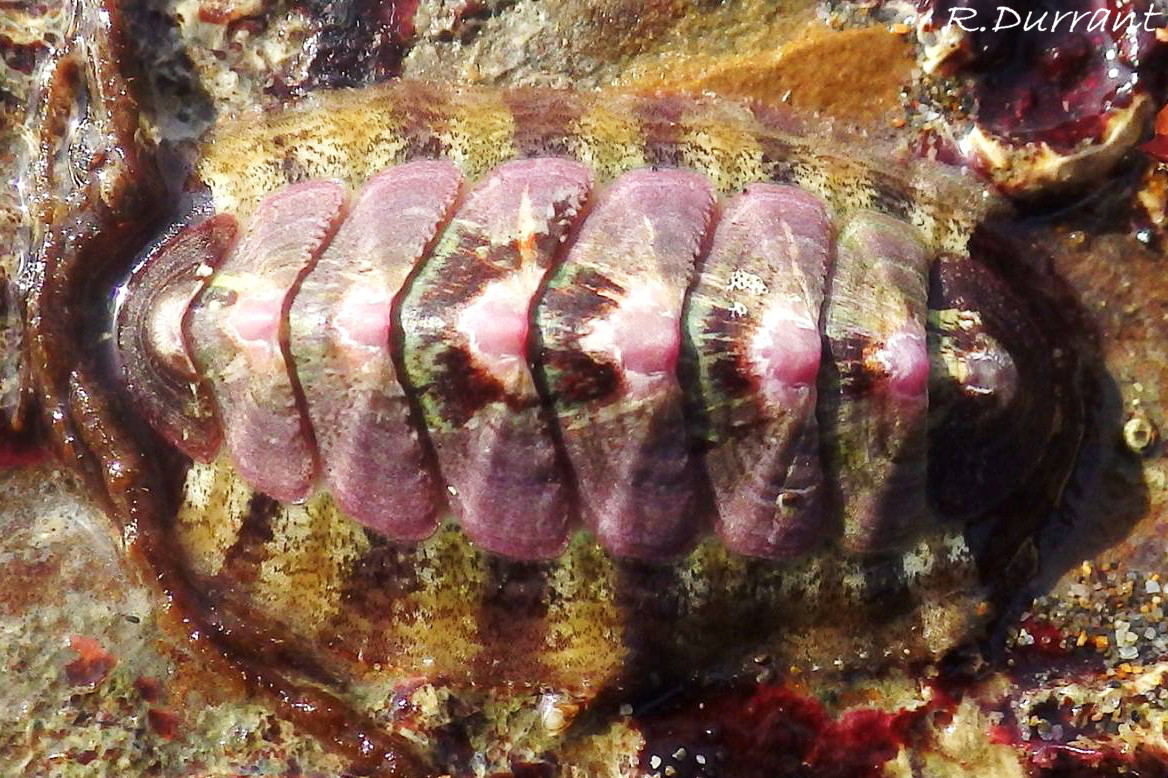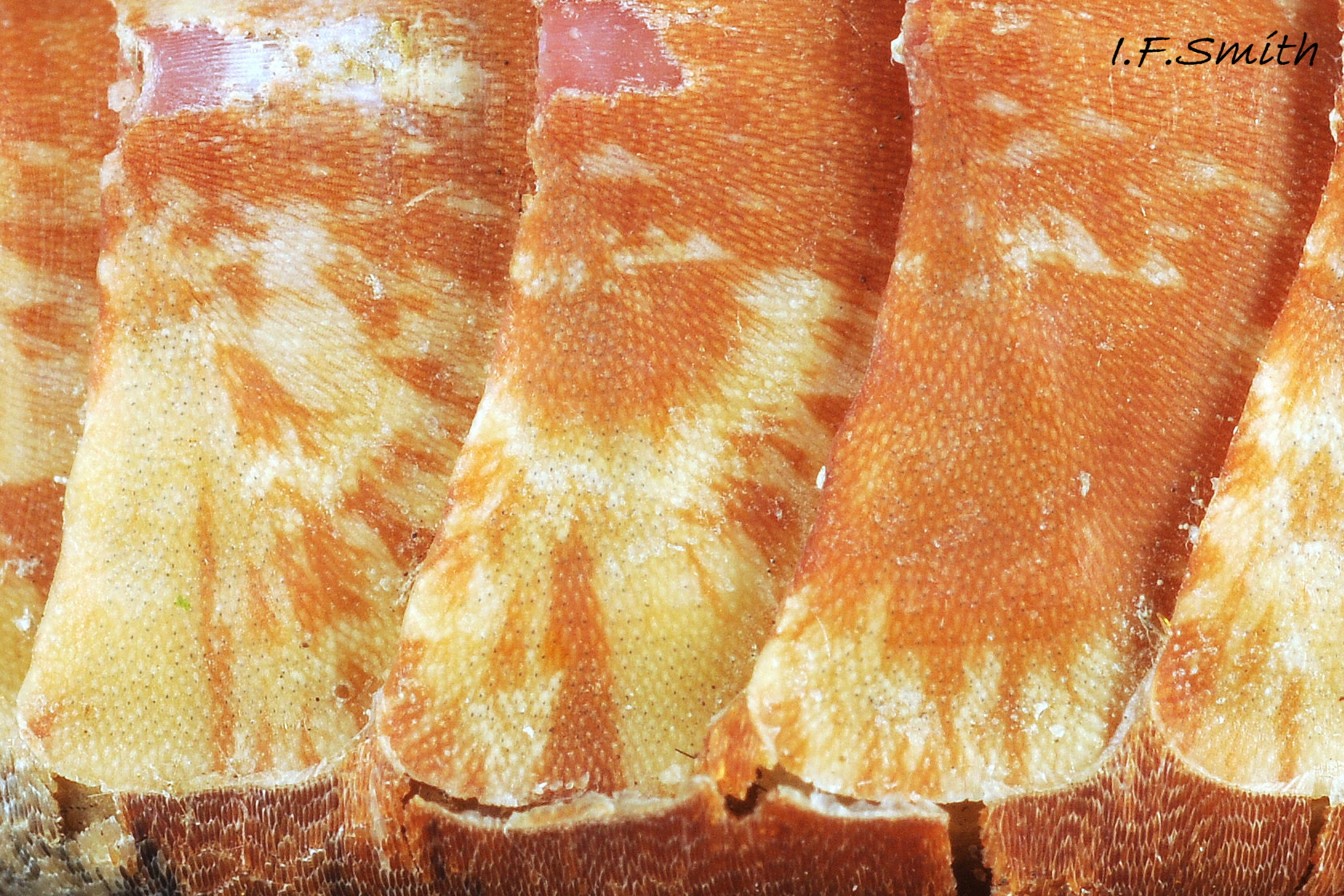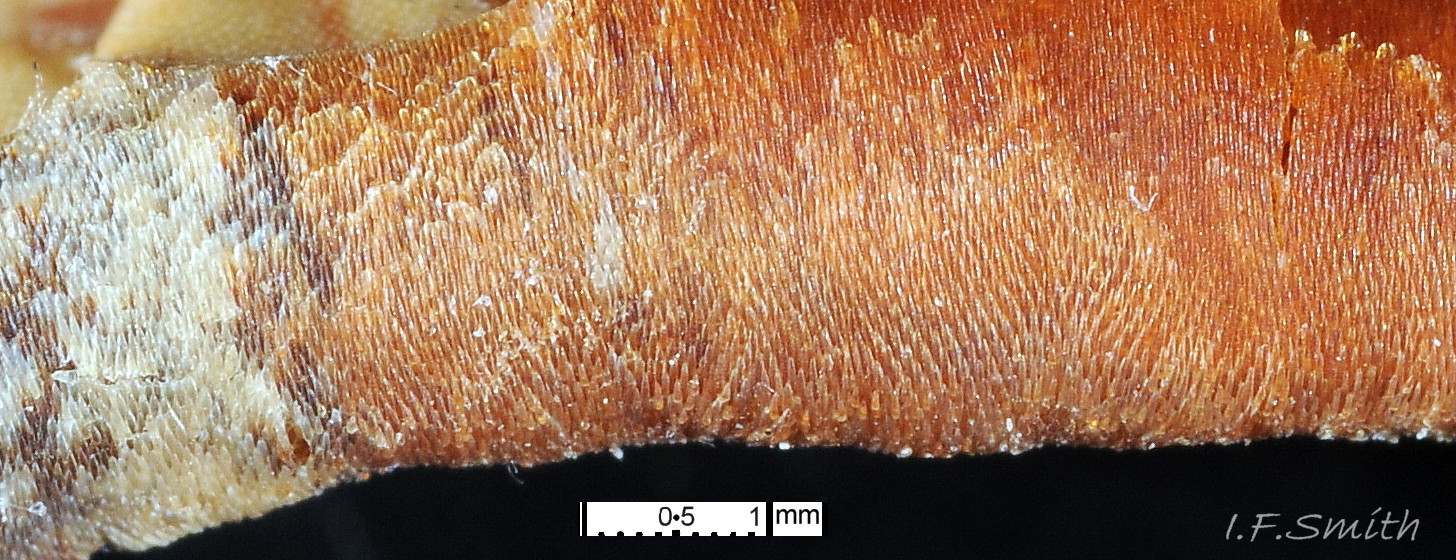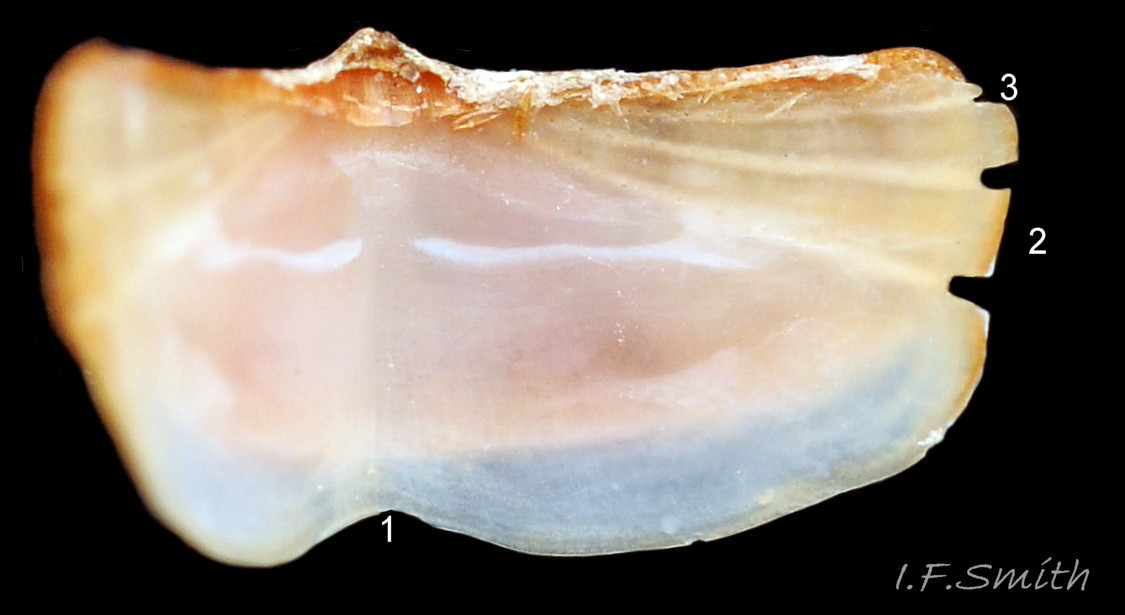Click image to enlarge with full caption. Main text below slider.
Tonicella marmorea (O.Fabricius, 1780)
Current taxonomy: World Register of Marine Species (WoRMS) www.marinespecies.org/aphia.php?p=taxdetails&id=14015…
Revised, 2020, PDF version at www.researchgate.net/profile/Ian_Smith19/researchImages: 1 to 54 T. marmorea; 55 to 59 vacant; 60 to 72 similar species.
Authors: Paula Lightfoot, Simon Taylor and Ian F. Smith.
Meaning of scientific name:
marmorea (Latin) = resembling marble
Synonyms: Chiton marmoreus O.Fabricius, 1780; Chiton ruber (non Linnaeus, 1767) Spengler, 1797; Chiton laevigatus Fleming, 1813; Chiton latus Lowe, 1825;
Vernacular: Mottled red chiton; Marbled mail-shell; Lleuen fraith y graig (Welsh); Chiton rouge marbré (French); Marmorierte Käferschnecke (German); Marmorleddsnegl (Norwegian); Marmoreret skallus (Danish);
GLOSSARY BELOW
This account adheres to the standardised terminology for chitons proposed by Schwabe (2010). Some of Jones & Baxter (1987) alternatives are indicated in the glossary as (a.k.a.).
Shell Description
Low form in N.E. Atlantic up to 45 mm long and 27mm wide 01 Tonicella marmorea . High form in N.W. Atlantic up to 37 mm long and 20mm wide (Kaas & Belle, 1985). In dorsal view, outline elliptical, larger specimens generally more strongly curved than smaller ones; width about 60% of length. Narrow girdle (total of two sides) occupies between 12% and 35% of animal width, specimens over 20mm length generally having the proportionally wider girdles (Baxter & Jones, 1986).
Eight overlapping valves 02 Tonicella marmorea have an upper coloured layer, ‘tegmentum’, of aragonite, and a lower layer, ‘articulamentum’, of white 03 Tonicella marmorea or, sometimes on jugal tract, pink 04 Tonicella marmorea or yellow 05 Tonicella marmorea aragonite. There are also an uppermost layer, ‘properiostracum’, and a discontinuous lowermost layer, ‘myostracum’, that are so thin and transparent as to be unnoticeable.
Dorsal surface (tegmentum) of valves appears smooth to naked eye apart from near-rectangular, distinct, growth lines 01 Tonicella marmorea & 06 Tonicella marmorea . Colour variable; dirty white, cream, various shades of brown 07 Tonicella marmorea , red 08 Tonicella marmorea , and ochre arranged in blotches or intricate zig-zag lines 09 Tonicella marmorea . Rarely entirely marmorated. Frequently, but not always, approximately triangular patches on the jugal areas have lighter colours 08 Tonicella marmorea . Valves ii, iv and, less consistently, vii often have more dark colour than the other valves 08 Tonicella marmorea , 09 Tonicella marmorea , 10 Tonicella marmorea , 11 Tonicella marmorea . Colour partly derives from pigment in properiostracum; brightest on live specimens in good condition and fades rapidly on specimens that are in poor condition or dead 12 Tonicella marmorea .
The head valve (i) is almost semicircular 13 Tonicella marmorea , with a shallow V posterior edge when viewed in situ on living specimen 07 Tonicella marmorea . The tegmentum on intermediate valves (ii –vii) has slightly rounded end margins, and nearly straight and parallel anterior and posterior margins 04 Tonicella marmorea , except the anterior of valve ii which projects more at its centre. Valves ii to vii have a keeled jugum 14 Tonicella marmorea with small posterior beak 15 Tonicella marmorea . Beaks are often eroded away 08 Tonicella marmorea .They vary in elevation (H/W% of valve iv) from 20% to 37% or more in NE Atlantic 17 Tonicella marmorea and usually higher in NW Atlantic c. 44% (Kaas & Belle, 1985). The side slopes of valves ii to vii are straight 16 Tonicella marmorea or slightly convex, or a combination of straight and convex when viewed from the anterior or posterior 17 Tonicella marmorea . Their lateral areas are very slightly raised and separated from the central area by a shallow, unobtrusive, diagonal depression 18 Tonicella marmorea & 20 Tonicella marmorea .
The tail valve (viii) is small and about twice as wide as its antero-posterior length. The unobtrusive, antemedian mucro is encircled by the concentric growth lines 13 Tonicella marmorea & 21 Tonicella marmorea . The steep postmucronal slope is straight in lateral profile 06 Tonicella marmorea . The colour of the antemucronal area resembles that of the jugal area of intermediate valves 13 Tonicella marmorea .
Canals permeate the tegmentum 22 Tonicella marmorea & 23 Tonicella marmorea and terminate on its dorsal surface as a minute stipple of caps (surface seems smooth to naked eye, at least 3X magnification and cleaned valve needed) 18 Tonicella marmorea on caps arranged in an offset grid pattern 24 Tonicella marmorea . Some canals penetrate the articulamentum to form holes on its ventral surface, especially in the slit rays and jugal tract 23 Tonicella marmorea & 25 Tonicella marmorea , 26 Tonicella marmorea .
Insertion plates on ends of valves ii – vii embedded in the girdle are separated by a single slit 05 Tonicella marmorea & 23 Tonicella marmorea ; head valve (i) has 7 to 13 slits 25 Tonicella marmorea and tail valve (viii) has 5 to 11 slits 27 Tonicella marmorea . On the ventral articulatum a diagonal slit ray runs from each slit to the posterior edge of valves i – vii 25 Tonicella marmorea & 26 Tonicella marmorea and from the slits to the mucro position where they meet the open canal ends in the jugum on valve viii 27 Tonicella marmorea .
The articulatum on valves ii – viii 03 Tonicella marmorea projects forwards as a pair of curved, wide, short (front to rear) apophyses separated by a narrow, straight, jugal sinus (gap) that is less than 25% length of an apophysis 28 Tonicella marmorea . The apophyses on valve ii are more angular and those on valve viii are smaller and more angular 04 Tonicella marmorea . Apophyses extend under the next valve forwards 02 Tonicella marmorea and leave a scar of similar shape on it when the connecting muscle is removed 29 Tonicella marmorea . The head valve (i) is the only one that lacks apophyses as there is no valve to its anterior to be attached to 25 Tonicella marmorea . [It is difficult to cut away the muscle without breaking the apophyses on freshly dead chitons. They can be disarticulated without damage to the valves by standing them in shallow 10% NaOH overnight. CAUTION; extremely caustic, burns skin and seriously damages eyes. Or, keep in preservative for some time until the muscle weakens and then pull the valves out with strong forceps]
Body Description
Head and foot only fractionally protrude into view naturally on live animal 30 Tonicella marmorea & and can usually only be seen when breeding 31 Tonicella marmorea or if the animal is dislodged from the substrate or adhering to glass. When attached to a smooth surface, the extended head is anteriorly convex to fit the curve of the shell, and posteriorly concave fitting round the anterior of the foot and extending laterally as mouth lappets 32 Tonicella marmorea . The shape varies when the head is retracted or unattached to the substrate 33Tonicella marmorea . The head lacks eyes and tentacles; its main feature is a large transverse slit-mouth with wrinkled lips. When preserved, the mouth may gape widely and its fleshy surround may distort to form a hood 32 Tonicella marmorea . As on chitons generally, the radula is a chitinous ribbon bearing teeth in rows of seventeen 34 Tonicella marmorea . In each row, the central (rhachidian) tooth is a reflexed, rectangular channel with a widened chisel-like terminal blade 36 Tonicella marmorea [The image and text in Jones & Baxter (1987) differs from this description of the rhachidian tooth which is based on SEM images in this account]. Next to it, the minor (first) lateral tooth is small and bladeless. The major (second) lateral tooth has a long shaft and a large tridentate head ( one small, sharp denticle and two wide, rounded denticles) 35 Tonicella marmorea . The first and second uncinal teeth are small and unobtrusive between the bases of the major lateral and major (third) uncinal tooth which has a long shaft with head shaped and sculptured like a feather 37 Tonicella marmorea. At the margin of the radula in each row there are three low plates (marginal ‘teeth’). The teeth are colourless when their formation commences at the rear of the translucent radula sac. They darken and harden through rust-red and brown as they move along the sac acquiring magnetite (iron oxide), and the principal cutting teeth are black by the time they emerge from the anterior of the sac 34 Tonicella marmorea . Magnetite is the hardest material made by any living organism (Botelho, 2013).
Aesthetes (sensory tissue) fill canals permeating the tegmentum 22 Tonicella marmorea & 37 Tonicella marmorea . They terminate on fine stipple (at least X3 magnification needed) 18 Tonicella marmorea as sensory organs on the dorsal surface of valves 19 Tonicella marmorea , 21 Tonicella marmorea , 24 Tonicella marmorea .
Canals vertically penetrate the articulamentum in the slit rays and jugal tract as conduits for branches of the body’s lateral nerve cord 22 Tonicella marmorea . Immediately below the valves, the mantle is tough, thin, translucent epidermis, but it is greatly thickened where reflected around the periphery of the shell to form a fleshy girdle 06 Tonicella marmorea into which the articulamentum insertion plates at the ends of the valves are deeply embedded 14 Tonicella marmorea & 38 Tonicella marmorea . The girdle has cream or yellowish-white flesh with a tough transparent yellowish cuticle that survives when flesh is removed with NaOH 39 Tonicella marmorea . The cuticle on the ventral surface of the girdle (hyponotum) and dorsal surface (perinotum) appears leathery-smooth to the naked eye 06 Tonicella marmorea , but strong magnification shows a covering of very small spicules 40 Tonicella marmorea & 41 Tonicella marmorea . Scanning electron microscope images 42 Tonicella marmorea show that the spicules on the (dorsal) perinotum are small, c. 27µ long, widely spaced cones with sharp apices, and that spicules on the hyponotum are longer, c. 35µ , more closely packed ovoids with longitudinal ribs. . The hyponotum is whitish, but usually extensively stained yellowish to brownish by firm contact with the substrate 43 Tonicella marmorea . The perinotum is yellowish with, usually, a brown or purplish band at each end of valves ii to vii, and several bands associated with valves i and viii 07 Tonicella marmorea . The bands usually have several yellowish blotches on them. Frequently, part or all of the perinotum is suffused with verdigris-green which partially obscures the band pattern 40 Tonicella marmorea . The foregoing colours are usual in Britain but Kaas and Belle (1985) state that the girdle is “of an even brownish colour, exceptionally with alternating zones of light and dark brown”. This may be the case in America, though 9 images from Quebec all have banded girdles (DORIS, 2019), and dried or preserved specimens often lose the pattern 12 Tonicella marmorea & 38 Tonicella marmorea . The edge of the girdle has a marginal fringe of straight, obtusely pointed, c. 48µ long, spicules that are very difficult to discern with the naked eye 42 Tonicella marmorea , 43 Tonicella marmorea & 45 Tonicella marmorea . The girdle can be flexed upwardly outwards at the anterior 30 Tonicella marmorea to admit inhalent water to the peripheral mantle cavity, and at the posterior to form a channel for the release of exhalent water, faecal pellets and ova or sperm 31 Tonicella marmorea .
An open narrow mantle cavity runs around whole animal; contains 15 to 26 small ctenidia on each side (Baxter & Jones, 1986), often on larger specimens for nearly the whole length of the foot (merobranch, but nearly holobranch, arrangement) 46 Tonicella marmorea & 47 Tonicella marmorea . Number of ctenidia increases with age. Between the mantle cavity and hyponotum the mantle fold is unobtrusive, except where it widens near the posterior into a mantle lappet 30 Tonicella marmorea and may partly conceal the ctenidia. Anus opens at end of an anal papilla into the mantle-cavity at posterior by a channel to the exterior formed by deflection/ depression of girdle 48 Tonicella marmorea . The dorso-ventrally flattened pericardium containing the heart is located above the anal papilla, and is sometimes partly visible on live specimens 48 Tonicella marmorea . Nephridiopores and gonopores open laterally into posterior quarter of cavity. No penis as external fertilization. Foot yellow to orange, elongate ovate, anterior wider than posterior, curvature of ends varies, sometimes truncate 49 Tonicella marmorea , no medial dividing line. When foot spreads widely, it and the mantle fold/lappet close and conceal much of the pallial cavity 44 Tonicella marmorea . The foot has many strong transverse muscles 50 Tonicella marmorea and the body has a strong lateral longitudinal muscle 38 Tonicella marmorea & 50 Tonicella marmorea that encircles the entire body passing under the outer margins of the valves. The valves have four sets of muscles.:
a) A pair of lateral muscles connect the foot to each end of the valves, one on each side of the slit 38 Tonicella marmorea & 50 Tonicella marmorea , leaving an opaque scar when removed 03 Tonicella marmorea .
b) A pair of straight muscles 51 Tonicella marmorea pass along the jugum, attaching to the anterior margin of the jugal sinus of each valve and to the body wall under the previous valve.
c) On each side of a valve an oblique muscle 51 Tonicella marmorea attaches to the jugal sinus close to the straight muscle and travels anteriorly outwards under the diagonal line that separates the lateral area of the tegmentum from its central area. The anterior end of the muscle attaches to the body wall under the preceding valve on which it leaves a comma shaped scar 03 Tonicella marmorea .
d) The transverse muscle 51 Tonicella marmorea consists of dorso-ventral fibres connecting the apophyses of one valve to the underside of the preceding valve where it leaves curved scars matching the outlines of the apophyses. The muscle colour is often the same as that of the jugal tract; white, yellow 51 Tonicella marmorea or pink 52 Tonicella marmorea .
Key identification features
There is interspecific overlap of many features. The most reliable are valve and girdle surface sculpturing.
Tonicella marmorea O. Fabricius, 1780.
Following is for NE Atlantic. Those in NW Atlantic may differ.
1. Big species. Max. length in NE Atlantic 45mm.
2. Colour variable; dirty white, cream, various shades of brown, red, and ochre arranged in blotches or intricate zig-zag lines. Valves ii, iv and vii often have more dark colour than the other valves 09 Tonicella marmorea .
3. Girdle is yellowish with a brown or purplish band at each end of valves ii to vii, and several bands by valves I and viii. Usually several yellowish blotches on bands 07 Tonicella marmorea . Frequently, part or all suffused with verdigris-green 40 Tonicella marmorea .
4. Apart from growth lines, dorsal surface of valves appears smooth to naked eye 06 Tonicella marmorea , but at over X3 (hand lens) magnification, numerous distinct small granules visible 18 Tonicella marmorea . (Granules may not be discernible in underwater images or on specimens before deposits and properiostracum removed.)
5. Dorsal surface of girdle (perinotum) has widely spaced minute granules (c.27μm long) 40 Tonicella marmorea . Usually escape notice in photographs; require strong magnification.
6. At LWS and sublittorally. Not found south of North Wales or Northumberland. (Many dubious records on mapping schemes as easily confused with T. rubra.)
7. 17 – 26 ctenidia along most of each side of foot, arrangement merobranch but nearly holobranch 46 Tonicella marmorea .
8. White apophyses on intermediate valves are short (anterior-posterior), wide and gently curved 28 Tonicella marmorea . Narrow jugal sinus (gap between them) is about quarter width of one apophysis.
Similar species
Boreochiton ruber (Linnaeus, 1767) (Formerly T. rubra)
1. Medium species. Max. length 15mm.
2. Dorsal surface of valves pink to brick red with patches and streaks of cream and light brown 60 Tonicella marmorea.
3. Girdle usually has reddish/pinkish bands alternating with pale bands. Pale bands, often fragmentary, usually thinner than reddish/pinkish bands, and roughly in line with shell-sutures 60 Tonicella marmorea COMPARISON Boreochiton ruber .
4. Apart from growth lines, dorsal surface of valves appears smooth to naked eye, but at X30 magnification (dissecting microscope). faint stippling is visible 61 Tonicella marmorea.
5. Dorsal surface of girdle (perinotum) has densely-packed, elongate (50 – 60μm), club-shaped granules with packed touching heads giving a mealy appearance. 62 Tonicella marmorea.
6. At LWS and sublittorally. All around Britain except NE Irish Sea and southern North Sea where hard substrate is scarce.
7. About 12 ctenidia each side (range 10-15), arrangement merobranch.
8. White apophyses on intermediate valves are prominent and rounded, often almost semicircular 61 Tonicella marmorea. Wide jugal sinus (gap between them) is about same width as one apophysis.
Lepidochitona cinerea (Linnaeus, 1767).
1. Medium species. Max. length 28mm.
2. Has diverse colour forms, some similar to that of other species 63 Tonicella marmorea.
3. Girdle usually has alternating brown (various shades) and whitish, transverse, lozenge-like bands of approximately equal size. Dark bands usually have narrow waist, and light bands usually have a bulging waist 64 Tonicella marmorea (or vice versa). A thin paler greyish longitudinal line often runs across the waist of dark bands. Usually a dark central spot on pale bands. Markings can be partially developed, very indistinct, or absent 63 Tonicella marmoreaon pale specimens.
4.Dorsal surface of valves has numerous rounded granules visible at X3 magnification, and often to naked eye. Granules tend to follow indistinct growth lines 65 Tonicella marmorea.
5. Dorsal surface of girdle has densely packed rounded granules 65 Tonicella marmorea.
6. Commonest littoral chiton all around Britain. Only chiton species likely to be found higher than MLW on British shores.
7. Usually 16 – 19 ctenidia each side, arrangement almost holobranch 66 Tonicella marmorea.
8. White apophyses on intermediate valves are gently curved. Wide curved jugal sinus (gap between them) on valve iv is about same width as one apophysis 67 Tonicella marmorea .
Callochiton septemvalvis (Montagu, 1803) (Formerly Callochiton achatinus
1. Big species. Max. length 32 mm.
2. Dorsal surface of valves usually some shade of red, sometimes yellow or green, with or without irregular blotches or marbling. Head and tail valves, i and viii, are often darker than the other valves 68 Tonicella marmorea. Minute black spot (X30 to see) by each apical cap of aesthete canals on valves i and viii, and on lateral triangle of intermediate valves ii to vii 69 Tonicella marmorea.
3. Girdle colour is usually a darker shade of the adjacent valve colour, often with a transverse cream band by sutures i/ii and vii/viii 70 Tonicella marmorea, and occasionally other sutures 68 Tonicella marmorea.
4.Dorsal surface of valves has numerous grooves that give a granular appearance visible at X8 magnification 69 Tonicella marmorea, but often not visible in photographs.
5. Dorsal surface of girdle has densely packed, tessellated, 200μm long, acicular spicules that create a characteristic snake-skin appearance 71 Tonicella marmorea.
6. Rarely numerous. South, west and north coasts of Britain. Scarce on east coasts; very scarce or absent in southern North Sea and north-east Irish Sea.
7. Usually 20 to 25 ctenidia each side, arrangement merobranch.
8. White apophyses on intermediate valves are short (anterior-posterior), wide and gently curved 72 Tonicella marmorea. They meet at the jugum with no jugal sinus (gap) between them. Only British species with two slits and slit rays (sometimes a small third one) in the articulamentum on either side of the imtermediate valves, ii to vii.
Habits and ecology
Lives on bedrock and stones at ELWS and sublittorally to about 200 metres, . Four sets of muscles to individual valves 38 Tonicella marmorea , 50 Tonicella marmorea , 51 Tonicella marmorea , 52 Tonicella marmorea enable shell articulation to conform closely to uneven rock surface. Large muscular foot and flat ventral surface of girdle grip the rock surface firmly 44 Tonicella marmorea . When displaced from the substrate, can use the strong, lateral longitudinal muscle to roll into a protective ball 53 Tonicella marmorea .
. Respiration: cilia on ctenidia and mantle create inhalent water-current entering pallial cavity wherever girdle is raised at anterior 30 Tonicella marmorea . Adjacent ctenidia have interlocking cilia so all work as a unit (as in many bivalves). Water current passes through ctenidia 46 Tonicella marmorea and then between foot and ctenidia as exhalent current to posterior where it exits via a channel through the girdle 48 Tonicella marmorea . Haemolymph (blood) circulates from the head sinus through longitudinal sinuses 46 Tonicella marmorea to the mantle, foot, and viscera, then through the ctenidia for aeration before passing into the adjacent heart in the pericardium 48 Tonicella marmorea below valves vii & viii. From the heart the blood is pumped through the medial dorsal aorta to the head sinus, giving off some channels to the gonad and valve muscles on the way. Chitons lack eyes and tactile/chemoreceptor tentacles on the head. They sense the environment through aesthetes exposed on the surface of the shell (only visible at high magnification) 19 Tonicella marmorea , 21 Tonicella marmorea & 24 Tonicella marmorea . Proposed aesthete functions include chemoreception, mechanoreception, replenishment of properiostracum materials, secretion of protective substances and photoreception, though the focusing lens and receptive retina found in aesthetes of some species are absent from T. marmorea. Sensory organs are also present on the girdle.
T. marmoreafeeds by scraping microalgae and associated organisms from the rock surface using its hard magnetite reinforced radula 34 Tonicella marmorea & 35 Tonicella marmorea . In some Scottish sea lochs where it is common, it is an important grazer in the ecosystem (Jones & Baxter, 1987). Though resembling early primitive molluscs in several ways, it has an elaborate digestive system with no trace of primitive rotating style in the stomach. Long coiled intestine compacts faeces into oval pellets 54 Tonicella marmorea . Exhalent water current in pallial cavity carries excreta from lateral nephridiopores to posterior, where faecal pellets from anus join the flow; all expelled at posterior through channel in girdle 48 Tonicella marmorea .
Breeding: dioecious. Water current in pallial cavity carries sperm or ova from lateral gonopores to posterior and out through channel in raised girdle. To facilitate wide dispersal the rear half of the body is raised from the substrate during release 31 Tonicella marmorea . As fertilization is external, synchronised emission of sperm and ova is needed to ensure success; trigger in many chiton species is moon-phase/ state of tides. Planktonic trochophore larvae hatch and metamorphose into small adult-form young without intervening veliger stage.
Distribution and status
Widely distributed in the northern North Atlantic, Arctic Ocean and White Sea from Novaya Zemlya, Spitzbergen and Baffin Island, Canada southwards to Northumbria and Wales (UK) and Cape Cod (USA). Records from further south need substantiation. Not in Baltic or continental coast of North Sea. Those in north-west Atlantic have some differences from those in north-east Atlantic. There are also records of it in the Pacific southwards to the Sea of Japan (B. Sirenko, in litt.). GBIF map www.gbif.org/species/2306814 . It can be common in Scottish sea lochs; up to 50 /m² (Jones & Baxter, 1987. NBN UK distribution map: species.nbnatlas.org/species/NHMSYS0021056553
Acknowledgements
For providing the specimens and/or images for this account I gratefully thank Rob Durrant, David Fenwick, Boyd Forrest, Dr Paula Lightfoot, David McKay, Dr Joanne Porter, Chris Rickard, Allan Rowat, Dr Boris Sirenko and Simon Taylor. I thank Dr Julia Sigwart for her valued specialist advice with the text and interpretation of the images; any errors or omissions are my (IFS) responsibility.
Links and references
Baxter, J.M. & Jones, A.M. 1986. Allometric and morphological characteristics of Tonicella marmorea (fabricius, 1780) populations (Mollusca: Polyplacophora: Ischnochitonidae). Zool. J. Linn. Soc.88: 167 to 177.
Botelho, A. 2013. Zoologger: mollusc grows hardest teeth in the world New Scientist 3rd October 2013 www.newscientist.com/article/dn24329-zoologger-mollusc-gr…
DORIS website; Tonicella marmorea. Accessed july 2019. doris.ffessm.fr/Especes/Tonicella-marmorea-Chiton-rouge-m…
Fernandez, C.Z., Vendrasco, M.J. & Runnegar,B. 2007. Aesthete canal morphology in twelve species of chiton (Polyplacophora). The Veliger 49(2) 51 – 69 www.researchgate.net/publication/246548141_Aesthete_Canal…
Forbes, E. & Hanley S. 1849-53. A history of the British mollusca and their shells. vol. 2 (1853) London, van Voorst. (As Chiton marmoreus; Free pdf at archive.org/details/historyofbritish02forbe/page/414 Use slide at base of page to select pp.414 to 417.)
Fox, R. 2007. Invertebrate Anatomy On Line. Katharina tunicata lanwebs.lander.edu/faculty/rsfox/invertebrates/katharina….
Hayward, P.J. & Ryland, J.S. 1995. Handbook of the marine fauna of north-west Europe. Oxford, Oxford University Press.
Jardim, J.A. & Simone, L.R.L. 2010. Redescription of Hanleya brachyplax (Polyplacophora, Hanleyidae) from the south-southeastern Brazilian coast. Pap. Avulsos Zool. (São Paulo) 50 no.40
www.scielo.br/scielo.php?pid=S0031-10492010004000001&…
Jeffreys, J.G. 1862-69. British conchology. vol. 3 (1865). London, van Voorst. (As Chiton marmoreus; Free pdf at
archive.org/details/britishconcholog03jeffr/page/226
Use slide at base of page to select pp.227 to 229.)
Jones, A.M. & Baxter, J.M. 1987. Molluscs: Caudofoveata, Solenogastres, Polyplacophora and Scaphopoda London, Linnean Society, and Estuarine and Brackish-water Sciences Association.
Kaas, P. & Belle, R.A. 1985. Monograph of living chitons Vol 2. Viderup, Denmark. Brill. Preview of Vol1at
books.google.co.uk/books?id=CKautf2EUPkC&pg=PA7&s…
Matthews, G. circa1954. The identification of British chitons. Papers for Students No.9. London, Conchological Society of Great Britain and Ireland.
Schwabe, E. 2010. Illustrated summary of chiton terminology. Spixiana 33(2):171-194.
Free pdf at verlag-pfeil.de/04biol/pdf/spix33_2_02.pdf
Glossary
μm = 0.001 mm, 1000μm = 1 mm
acicular = slender and tapering to a point; needle-like.
aesthetes = complex of canals and cavities filled with sensory tissue that permeate tegmentum and locally penetrate articulamentum. Open as sensory pores on dorsal surface of valves; probably compensate for lack of sensory structures on head. Some sense light; other sensory function(s) uncertain, but various authors have variously proposed chemoreception, mechanoreception, properiostracum replenishment and secretion of protective substances.
a.k.a. = also known as.
antemedian = (syn. antemedial) situated to anterior of middle.
antemucronal area = area situated to anterior of mucro.
apophysis = (pl. apophyses) anterior extension of articulamentum which underlies preceding valve; on all valves except head valve (i).
aragonite = orthorhombic crystalline mineral-form of calcium carbonate www.minerals.net/mineral/aragonite.aspx . Less common on land than calcite, but, currently, the more frequent mineral-form in oceans and living mollusc shells.
articulamentum = inner shell-layer of chiton valves, usually hard, white, porcelaneous aragonite and often differently coloured in central part.
calcite = trigonal crystalline mineral-form of calcium carbonate www.minerals.net/mineral/calcite.aspx . More common on land than aragonite, but, currently, the less frequent mineral-form in oceans and living mollusc shells. More resistant than aragonite to acid rain corrosion; forms outer shell layer of shore-dwelling Littorina species in cool climates. (Corrosion of calcium carbonate faster at cold temperatures).
cephalic = (adj.) of or on the head.
chemoreception = sensing of chemicals; “smell / taste”.
chitin = semitransparent flexible horny protein. Does not occur in molluscs.
chitinous = (adj.) resembling chitin.
cilia (pl.) = motile linear extensions of membrane used in locomotion, or to create water currents in feeding. (“cilium” singular).
coll. = in the collection of (named person or institution) (cf. legit).
ctenidium = comb-like molluscan gill; usually an axis with a row of filaments either side.
dioecious = having separate male and female individuals.
dorso-ventrally flattened = as if pressed flat from above.
ELWS = extreme low water spring tide (usually near equinoxes).
epithelium = tissue forming outer layer of body surface, “skin”.
girdle = (on chiton) peripheral band of thickened, reflexed mantle that encloses ends of valves.
gonopore = genital opening through which eggs or sperm are released.
holobranch = (of chitons) ctenidia in mantle cavity extend full length of foot.
hyponotum = ventral cuticle of chiton’s girdle.
insertion plate = (on most chitons) extension of articulamentum which inserts into mantle on lateral margin of intermediate valves, anterior margin of head valve and posterior margin of tail valve. Inserts into, and anchors valve to, the girdle muscle block.
intermediate valve = (of chiton) any valve (ii – vii), except head valve (i) and tail valve (viii).
jugal area = summit zone of chiton valves on dorsal surface.
jugal tract = summit zone of chiton valves on ventral surface.
jugum = summit of chiton valves.
lateral area = (on intermediate valve of chiton) triangular area with its base along lateral edge of valve and its apex near the centre of the posterior edge. a.k.a. lateral triangle.
legit = (abbreviation; leg. or lgt.) collected/ found by (cf. coll.)
LWS = low water spring tide, two periods of a few days each month when tide falls lowest.
mantle = sheet of tissue that secretes the shell and forms a cavity for the gill in most marine molluscs.
mantle cavity = (on chitons) a.k.a. pallial groove; narrow groove around whole foot and head, roofed by mantle and containing ctenidia, nephridiopores and gonopores.
magnetite = mineral of iron oxide, hardest material made by any living organism.
marmorated = veined or streaked like marble.
mechanoreception = sensing of touch, sound, pressure change and/or posture.
MLW = mean low water mark.
merobranch = (of chitons) gills in pallial cavity only in posterior two-thirds of animal.
mucro = projection on tail valve (viii) of chiton demarking posterior from rest of valve. Varies in prominence and position.
myostracum = thin, inconspicuous, discontinuous, innermost layer of chiton shell.
nephridium = tubular glandular excretory/ osmoregulatory organ. a.k.a. kidney.
nephridiopore = opening of nephridium for excretion. a.k.a. renal pore.
odontophore = firm, approximately ellipsoid, structure of cartilage supporting radula. Protruded like a tongue to operate radula.
pericardium = membranous sac containing heart and start of aorta.
perinotum = dorsal cuticle of chiton’s girdle.
pleural area = (on intermediate valve of chiton) triangular area with its base along anterior edge of valve and its apex near the centre of the posterior edge. a.k.a. median triangle.
postmucronal = situated to posterior of mucro.
properiostracum = (on chitons) outermost layer of colour-bearing proteinaceous material, sometimes resembling collagen in texture and differing in composition from periostracum of most other mollusc groups.
plankton = animals and plants that drift in pelagic zone (main body of water).
radula = chitinous ribbon of teeth extruded on a tongue-like structure (odontophore) to rasp food.
side slope = (on chiton) shape in profile view (from posterior or anterior) of lateral areas of intermediate valves; may be straight, convex, concave or a combination of these.
sinus = 1. dilated channel or receptacle containing blood etc. 2. (re. chiton valves) curved bay or gap.
slit ray = row of canal pores running diagonally from lateral slit to posterior edge on ventral surface of chiton valve. a.k.a. notch ray.
suture = (of chiton) line where two valves meet.
tegmentum = outer shell-layer of chiton valves, usually porous and relatively soft. (Covered by transparent properiostracum when live.)
trochophore = spherical or pear-shaped larvae that swim with aid of girdle of cilia. Stage preceding veliger, passed within gastropod egg in most spp. but free in plankton for limpets, Trochidae, Tricolia pullus and (with no veligers) chitons.
uncinate = having a hooked shape.
uncinate blades = largest two teeth in each row of seventeen on chiton radulae; principal scraping blades. Often darkened more than other teeth by high magnetite content.
veliger = shelled larva of marine gastropod or bivalve mollusc which swims by beating cilia of a velum (bilobed flap).
